
gaf
-
Posts
211 -
Joined
-
Last visited
Content Type
Profiles
Forums
Store
Help Articles
Posts posted by gaf
-
-
Pushing Asia – Bo Innovation – Hong Kong
Molecular Cuisine has become a global brand, a reality that has led some to suggest that its time has passed: the sun has set on foam, night has made deconstruction invisible. As an avid diner, my suspicion is that some of the bubbly enthusiasm has waned, but this is not necessarily a bad thing for the cuisine. We are at the point where experiments are not done for their own sake, but because they actually taste good – they create memories on the palate.
In my attempt to collect stamps from all of the global molecular post offices, I knew that I would have to visit Bo Innovation on my trip to Hong Kong, presided over by “Demon Chef” Alvin Leung. In the 2009 Michelin Guide to Hong Kong, Bo Innovation received two stars, but in the 2010 guide was demoted to one (perhaps revealing the danger of palling around with Anthony Bourdain on “No Reservations” and god knows where else! How many bad boy chefs can one world take?).
But one star or two, Bo Innovation is a happening place, and eating at the kitchen “bar,” chatting with the cooks and servers, it reminded me of an Asian version of Washington’s Minibar. I give a lot of credit to AJ, the maitre d’, Mark, one of the servers, and Leah who was staging, for making my evening so congenial.
Bo Innovation’s ploy is a relatively simple one – clever and generally successful. Chef Leung marries the techniques the molecular cuisine (cuisine agape) with a mixture of Asian and western flavors, but with an emphasis on luxe ingredients: the restaurant describes themselves as creating “x-treme Chinese cuisine.” Diners are required to order the tasting menu, which on the night I visited was approximately nineteen courses (depending, of course, on how one counts such things).
As is so often true, not every course was fully satisfying. (The fact that French Laundry, Alinea, and a few others do makes their three stars all the more impressive). However, the ratio of hits to misses was agreeably high. While at times it seemed as if each dish was centered around a single Chinese ingredient, rather than being fully Asian, the incorporation of mou-tai, dried shrimp, lotus, or yak cheese added a sense of Orientalism to a menu that was structurally not so different from Minibar. One wonders if molecular cuisine can ever be truly Chinese, given different styles of cooking and presentation – and theories of food – or whether experimental cuisine will inevitably Western with Chinese touches. Bo Innovation does not fully answer the question. But if Bo Innovation is not stratospheric in its creativity, there was enough vision to allow the meal to be worth recalling with delight.
Chef’s table menu: January 23, 2010
1) Mou-tai Sour combined with fluffy egg whites – a pleasant amuse and palate cleanser. Although Chef Leung incoporatored Mou-tai (the Chinese liquor made from sorghum molasses, giving the drink a light molasses taste), it was basically a standard molecular treatment.
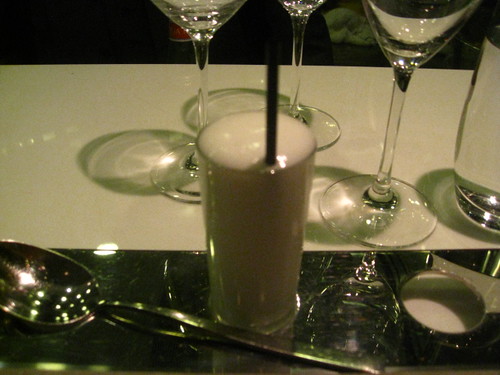
2) Escargot with compressed watermelon, Sichuan vinaigrette with crispy garlic, fried greens – beautifully composed, but again the style is Western with Chinese ingredients.
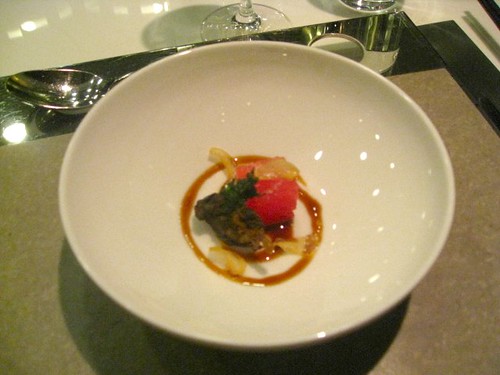
3) Caviar with smoked quail egg and crispy taro – Kaluga caviar from China – reminiscent of Thomas Keller’s Pearls and Oysters – a beautiful dish

4) Hamachi with black sesame, crispy rose essence ginger – beet juice for ginger, amazing Japanese inspired – for my taste this was the most accomplished dish of the evening.

5) Sea Urchin, ink noodles, chili oil, and “har mi” (Sun-dried shrimp) – very distinctive taste, brave flavors, although perhaps too strong in terms of what came before and after.
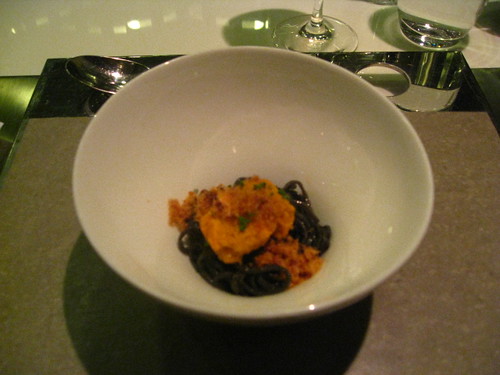
6) Black truffle sandwich, “chian dan chee” – crispy spam and egg sandwich with truffles – one of the best sandwiches I have had with a distinct truffle aroma. Chef Leung is in this menu quite partial to truffles.
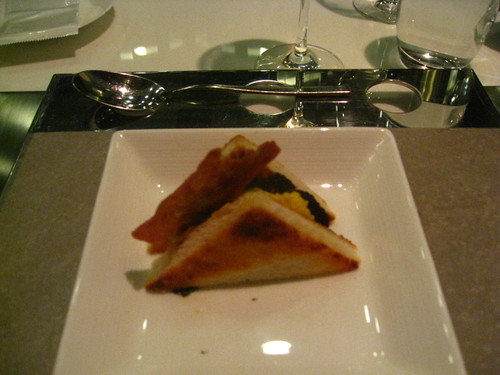
7) Iberico 36 (months cured ham) with morels and porcini, Korean vermicelli, and onion foam – one of the best dishes of the night, a one-bite wonder that effectively combined tastes.
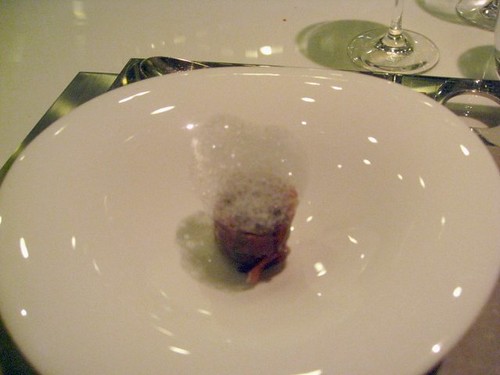
8) Molecular “xiao long bao” – a “dumpling” in a bladder – pork stock with a line of pickled ginger on top, but how Chinese was it really. A cute and pleasant dish, but limited in its appeal. The idea overwhelmed the taste.
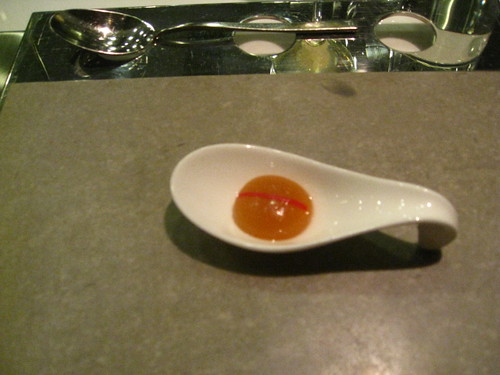
9) Yak and Mac – with black truffle bits – ok, but not so different than mac’n’cheese – Yak cheese, not as good as the yak butter tea that I had from a Yunnan food stall a few days before. But another cute idea.

10) Frog Leg “beggar style” – frog thigh stuffed with lotus and shiitake – on small diced vegetables (again, despite the fact that it was based on a traditional Chinese dish, one wonders how Chinese it was? It seemed like a Western appropriation of Chinese cuisine.) Still, the flavors were impressive.
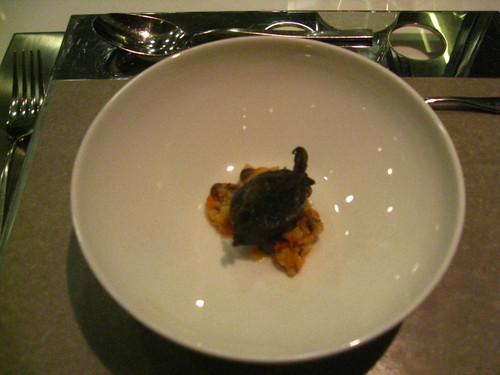
11) Scallop with sesame, kaffir lime, grape aspic, quite beautiful and contemporary in conception

12) Foie Gras with black truffle and turkey congee, looked the same as the yak and mac – a joie d'esprit – a savory donut underneath (no photo – see the photo for Yak and Mac)
13) Halibut with shiitake soil, “yun nam” ham powder, extra virgin olive oil, reminiscent of the “soil” dishes of Wylie Dufresne at WD-50 (no photo)
14) Sweetbread – oyster sauce (somewhat think but bright) lettuce tempura, artichoke puree – excellent dish; impressively prepared, but it is the oyster sauce than made it Asian.

15) Chalon duck with longon, red rice and preserved kumquat – too gingery to my taste, and one of the least successful dishes of the night.
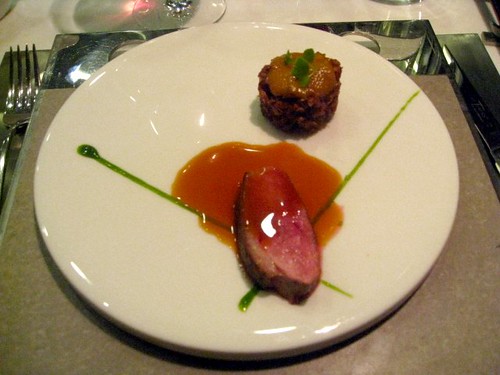
At this point I was served several desserts, which in general were not as inspirational as the savory courses:
16) Almond with sandalwood smoke – a nosegay that is reminiscent of some experiments at Alinea – “Chinese temple”, nice almond ice cream but not revelatory.
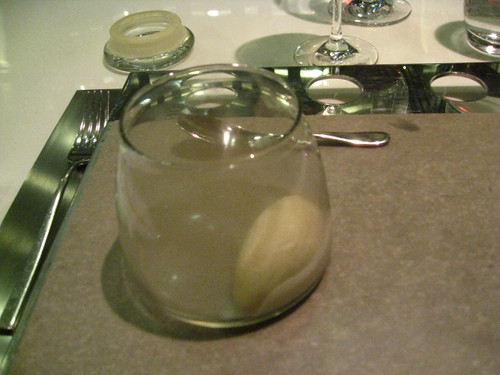
17) Shui Jing Fang – poached caramelized banana and dark chocolate ganache (but served without chocolate since I am caffeine sensitive) mint, rice wine liquor – very nice, and probably better with the ganache.
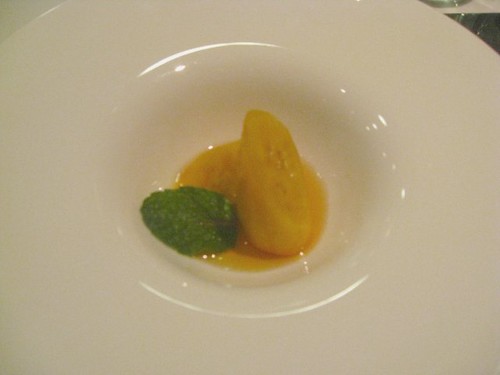
18) Chinese petit fours: kaffir lime macaron, red date marshmallow, salty fudge (no photo)
19) Jasmine kiss – jasmine flowers with liquid nitrogen – another fragrant moment with a tip of the toque to Grant Achatz at Alinea.

I left being fully satisfied by the evening. Bo Innovation provides four-star cuisine, but in its glory raises the question of how Asian molecular cuisine can truly be. Is molecular cuisine always and ever to reflect Western culinary imperialism?
Bo Innovation
Shop 13, 2/f, J Residence
60 Johnston Road (lift on 18 Ship Street)
Wan Chai, Hong Kong
852-2850-8371
-
First Day – Hong Kong – Shanghai Xiao Nan Guo Cuisine
The Jumbo Kingdom Floating Restaurant off Hong Kong Island, near the Aberdeen Fishing Village (more like a very large and diverse marina) is a sight to be seen. It is a huge Hong Kong dim-summary: a gathering for parties, banquets, and tour lunches, although not a place to eat more than serviceable dim sum, less impressive than good (not great) establishments in New York, San Francisco, or even Chicago.
I spent much of my first day in Hong Kong on a Gray Line tour to gain a sense of the city, and the Jumbo was where they parked us for lunch. The dim sum selections, understandably, if sadly, were from the dark edge of the menu: a dry Steamed Barbequed Pork Bun, a greasy shrimp egg roll, bland curry noodles, and a flavor-challenged shrimp dumpling. The only two passable dishes were those that I ordered personally, a sweet Chinese Ginger Juice Pudding although with only a whiff of ginger, and a crispy fried sesame beef ball dumpling. The greatest compliment that such a meal can receive is: filling.

Things improved in that evening when my host – a Hong Kong native – selected a Shanghai restaurant, the Tsimshatsui branch of a chain, Shanghai Xiao Nan Guo Cuisine. The ambiance was clean and pleasant, muted, although somewhat generic, more what one describe as international style than distinctly Chinese (if Hong Kong can, in fact, be considered distinctly Chinese).
The first surprise came at the start of the meal when water arrived (Jetlagged, I didn’t care for tea). The water was served hot, which my friend informed me is considered healthful in China. The second liquid surprise was the Chinese rice wine – rather like a sweet, dark sherry, also served warm (like sake). When a dried sour plum was added the wine gained a distinctive and pleasant musky fruit aspect.
Even though there were only two of us, we ordered enough for a platoon: Asian trenchermen. The meal began with pungent marinated duck tongues. The enjoyment of the meat (and the very idea of the dish – no worse, surely, than foie gras) was moderated by the difficulty of consumption, nibbling the edges of cartilage while mismanaging chopsticks when half asleep: getting the tongue in my maw was easy, in removing less picturesque.
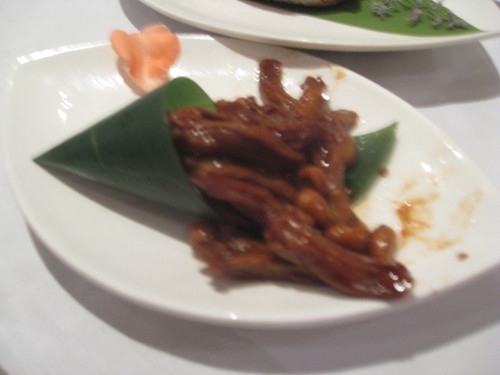
The tongues were soon followed by a pair of lightly fried crispy yellow fish – a small white fish with a yellow tail (not tuna-type yellowtail), the size of a large herring. It was beautifully fresh, airy, and crackly in all of the ways that fried food reveals its perfection.
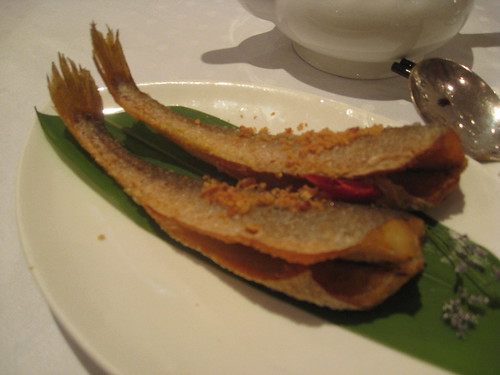
Steamed pork dumplings are a well-known Shanghai speciality, and these bocce balls, with soup hidden inside were sturdy if not startling examples of the genre. Less special – and heavy – was sticky rice with pork rib. I am confident that this dish is no worse that how the dish was intended, but it lacked a special appeal.
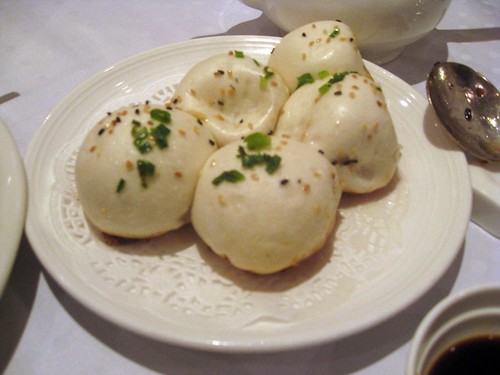
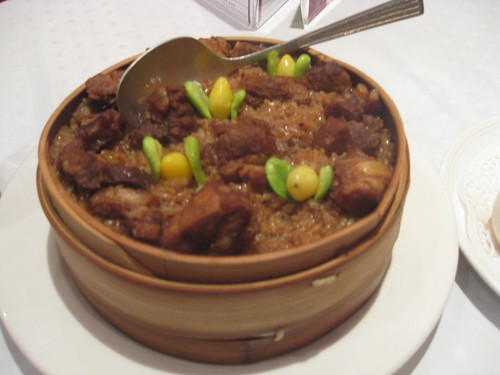
For me – and my companion – the high point of the night was Fish Maw with Crab Yolk, advertising the Shanghai expertise with seafood. Astonishingly this dish was both eggy and slightly sour, a citrus note that cut through what could have been the unctuous quality of the loose egg sauce. Its revelatory golden color added to its appeal, as did the delightful fish maw and sweet crab. This plate was both inspired and awakening.
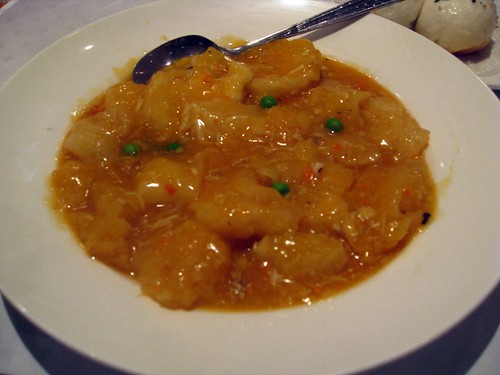
We ended the evening with two sweet soups. First, was a light and fresh Papaya in Broth: a wake-me-up that would served as a palate cleanser had it not been warm. The final soup was a sugary rice wine soup with gelatinous rice balls. Had it remained with these ingredients, it would have been too heavy for a final note to this long symphony. Fortunately, in the liquid were some dried flowers which transformed this dessert into an incredibly fragrant memory – enough to recharge us into the warm January Hong Kong night on our way to the elegant Felix bar at the Peninsula.
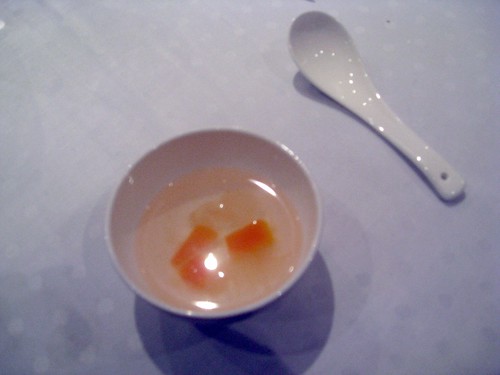
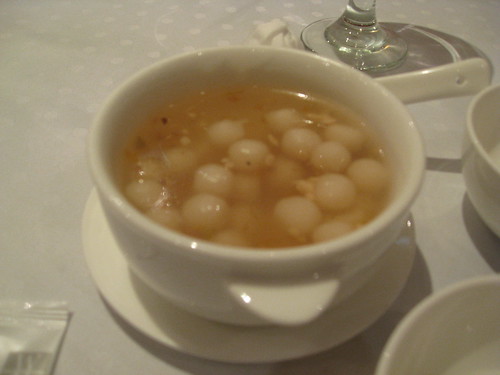
Jumbo Kingdom Floating Island Restaurant
Aberdeen Fishing Village
Shum Wan Pier Drive
Hong Kong
2553 9111
Shanghai Xiao Nan Guo Cuisine
Unit 2, Level 6, MegaBox,
38 Wang Chiu Road,
Kowloon Bay, Hong Kong, China
2369 8899
-
Cantonese Memories – Lung King Heen – Hong Kong
By some accounts Lung King Heen, the three-star Michelin restaurant on the fourth floor of the Four Seasons Hotel in Hong Kong with its stunning view of the harbor, may the best Chinese restaurant in the world. Certainly no other Chinese restaurant has received such Michelin praise. When I visited Hong Kong last month, Lung King Heen was on my agenda. I had read about the strengths of the restaurant and was fortunate to rely upon the experience of “Ultimate Epicure,” and so did not choose blindly from the extensive menu, although I also relied on the guidance of my savvy server.
There is much to commend the food. But what I remember most clearly relates to the fact that I was dining alone. When I sat down, I was provided reading material for the time between courses: Travel and Leisure and Christophorous Magazine, a magazine designed for Porsche owners, perhaps LKH’s market niche. Should I have been grateful (or disappointed) that I was not given the Guangzhou edition of Maxim? Different stokes, as they say.
Cantonese cuisine used to be China’s culinary ambassador to the global maw, but today the style is seen less as exotic, but as fusty. However, Lung King Heen demonstrates that such a patronizing perspective is not essential. With its lengthy menu of well over 100 items, the kitchen is both skilled and flexible. I have had others Chinese dishes whose taste adheres to memory, but few that make such a claim to sheer opulence. The meal was superior, and yet surprise sometimes bowed to technique.
The innovative chef amazes from the first bite: the amuse astonishes. This was not the case at Lung King Heen, where my first bite was the saddest. I begin with a tiny plate of crispy squid, tomato, and cucumber. The squid, heavily breaded was anything but crispy, and rather tough. What was I doing here? Were the Michelin inspectors asleep?

My appetizer selection was imperfect, but more satisfying. I received a trifecta of roast goose with plum sauce, BBQ pork with honey, and BBQ suckling pig. The technique impressed me, but the small dishes varied in their pleasure. The goose was somewhat tough and the sauce was too cloying for pleasure. The pork was impressively sumptuous, but perhaps overly fatty. In contrast, the pig with a square of crackly skin atop was a memorable travel into the heart of pork with skin as crisp as crème brulee.
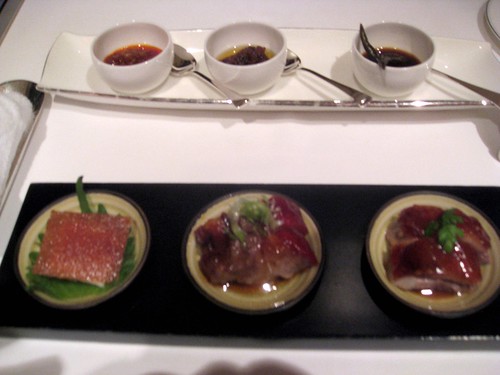
Shark fin soup is not likely to be available much longer. One bends one’s knee to animal rights. I received a wallop of criticism from friends who don’t blink at eating eyeball tacos or blanch at foie gras. Still diners wish for a full life, if that can’t be said of the object of their appetite. I selected a $100 US soup: Braised Superior Shark Fin Supreme Broth with Lobster and Gold Leaf. Here is conspicuous consumption that Thorstein Veblen would appreciate. The taste of this soup is not overwhelming, but the aroma and the texture is powerful. Perhaps I will never again choose shark fin, but this experience will last. The dish was a concatenation of subtleties, and in this revealed the artistry of Cantonese cuisine. The chicken broth was a divine gift. The shark fin amazed, slightly chewy and slightly slippery: translucent but solid. The small amount of lobster was a fair partner for the broth. The gold, not strictly necessary, reminded me that this was to be the only C-note soup I would ever order.
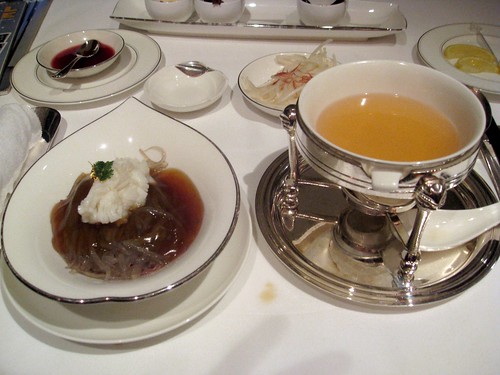
I followed this extravagance with a plate of wok-fried prawns with dried chili and shallots. Unexpectedly the chilies were not Sichuan-hot, but intensely flavorful. During my travels in southern China, I was served only a handful of dishes that reminded me of the “spicy-oily” dishes so common in American Chinese restaurants. At Lung King Heen the heat never overpowered the ingredients, with shallots and cilantro providing a depth of flavor. Not a novel combination, the dish was intensely satisfying.
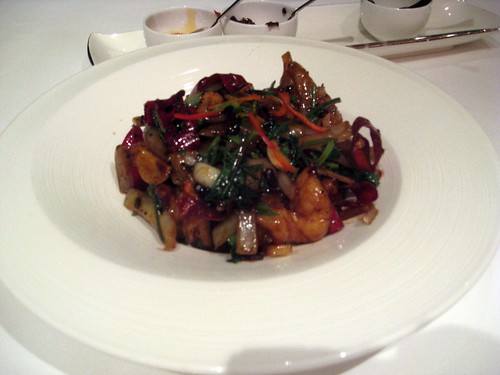
I completed my entrees with a luscious dish that I surely would not have selected had it not been for Ulterior Epicure’s advice: braised e-fu noodles with fresh Alaskan crab meat in Champagne sauce. East meets west. The sauce was as rich as any pasta sauce I can image: a roll in butter and bubbles. Crab, tender and sweet. The sauce had a French consistency, and the noodles a Chinese bite. E-fu power was the echo of luxe. For a moment I became a titan of industry passing between two worlds.
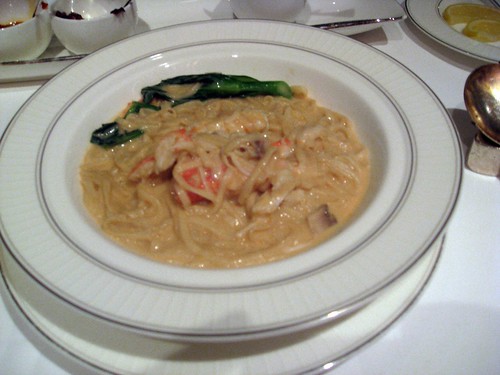
What Cantonese banquet would be complete without a Bird’s Nest? Rather than selecting a savory bird’s nest course, I chose dessert: double-boiled egg white milk custard with bird’s nest. The flavors were never overpowering, but the textural subtly matched the flavor notes with hints of ginger. The dessert was so remarkably smooth and so light that it might have been avian.

In all, I felt well-satisfied with Lung King Heen, even if I recognized the many leagues between the Four Seasons experience and the traditional Cantonese table. Still, when in Hong Kong, one might as well pretend to be Governor General.
Lung King Heen
Four Seasons Hotel
8 Finance Street
Central
Hong Kong, China
(852) 3196-8888
http://www.fourseasons.com/hongkong/dining/lung_king_heen.html
-
Minibar Revolution – Minibar – Washington, DC
For the culinary community, the 00’s were the Molecular Decade – for butter or for wurst. In the 90s Ferran Adria was still figuring out his chemistry set, but it took Y2K to fashion a craze. One cannot fairly say that Cuisine Agape ever dominated, but many culinary capitals birthed restaurants that played games with your food. From Barcelona to Bray, Paris to New York, from the near west side of Chicago to the near north side of Chicago, experimentation was the game’s name. And, it must be said, that the gourmet decade had it all over the political decade. We can look back with satisfaction and not shame; after all those calories we really need some health care.
To end the decade, I returned to Minibar, Chef José Andrés’ outpost in his Café Atlantico in downtown Washington. Short of underground dining, short of El Bulli, Minibar is the toughest reservation to cadge. It took four mornings, calling at the moment that lines were open finally to snag a spot. (There are two seatings of six each. Sorry, Octomom!) The object is to be up-close-and-personal with the chefs: a sushi counter gone wild. Such a structure makes for agreeable conversation with the staff, but perhaps limits what can be produced by the team of four, working in tight quarters under our hawkish gaze.
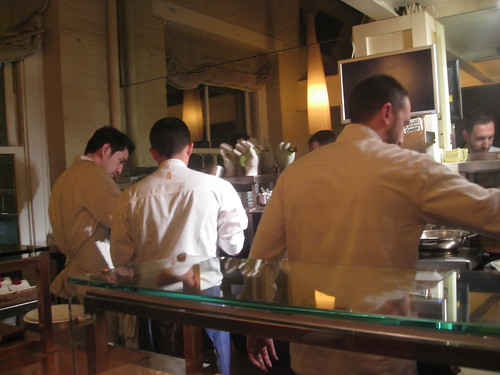
I had eaten at Minibar two years previous and was impressed with the creativity and panache. How did it wear? Was Minibar a two-trick pony? The answer is complicated.
Artistic revolutions have their life cycles. First, there are the pioneers, the rebels. But there are only so many ideas under the dining moon. In time even the most remarkable sparks of deconstructed genius become matters of routine. The craft remains, but the new dishes are often modifications of canonical recipes. The history of aesthetic insurgency is that of trick or tweak. In time, passion becomes passé: been there, ate that. At that moment, others, more traditional, emerge to pluck the best ideas and blend them with the tried and true: that’s what happened with Careme, Escoffier, nouvelle, and fusion.
We are, it seems, in-between the moments of modification and incorporation. Soon chefs will not strain to foam. But by then even the most conventional chef will place pop rocks in their mise en place for that perfect plate.
Minibar remains an essential restaurant and certainly will be eye-opening for anyone who has never been exposed to molecular cuisine. My challenge was to find the lasting memories among the fusty standards (if a mojito bladder can be derided as fusty or as standard). Depending on how one counts, I was served two dozen courses. Eleven “munchies.” Ten “flavors and textures.” Two desserts and one plate of mignardises (or “sweet surprises”).
Andrés and his chefs are still capable of revelations, even if some dishes are more curious than eternal. A description of twenty four dishes seems excessive even for the most bilious blogger (the photos provide evidence of the chef’s handiwork), but there were some goofs. I was not taken with the “Bagels and Lox,” a small hors d’oeuvre that was little more than lox balls in a bready cone. The flourless blue cheese and almond tart was tasty enough, but nothing special, although being served in a bowl of rocks was an enjoyable conceit. The carbonated mojito bladder was fun, but more a cunning culinary stunt than a dish that led to seconds. The same could be said for the parmesan “egg” that was more cute than delicious.
What is necessary in our Tweens is for brave chefs to create brilliant dishes. We have moved beyond being satisfied with the astonishment of the concept (Wow, shards of glass in the fruit salad, so this is a blood orange!) to demanding dishes that are luscious, creative, and brimming with sensation. Fortunately there were several dishes at Minibar that deserve this acclaim. Other dishes deserve nods. A hot and cold Pisco sour, a tempura Brussels sprout, a raw smoked oyster with apple and ginger, an inside out reconstructed guacamole, a charcoal salmon with black garlic and lemon-lime pearls all stood firmly on their own. However, I focus on four dishes that represented for me what molecular cuisine can achieve, but often does not.
First, there was the now obligatory cotton candy display: chefs at the funhouse. But at this carnival, cotton candy eel with shiso leaf, wasabi, and ginger really did transcend. Forgot that it was “cotton candy,” but feel the texture and taste the ingredients. The wispy filaments contributed to the exoticism of this proto-Japanese dish with its symphony of senses. It was brilliant, transcending the brittleness of the conceit.
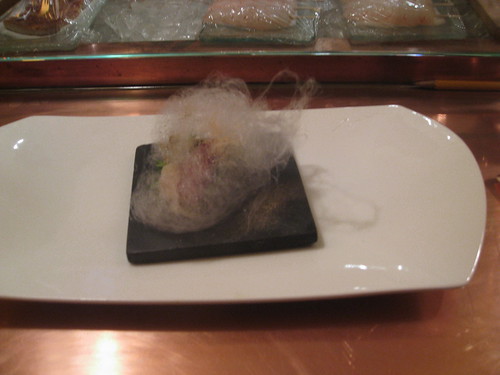
Second was Zucchini in Textures, a signature Andrés dish (it was served two years ago). The taste was subtle, not boisterous, and the textures were sublime. It elevated this rather pedestrian summer squash to the winter heights. Each level - the water, the seeds, and a puree - was precisely achieved. It is a contemporary classic: quieter than Keller’s Oysters and Pearls or Carlson’s Quail Egg Ravioli, but just as subversively memorable in its spare delight.

Third, late in the meal, was Breaded Cigala with Sea Salad (sorrel, I believe). Cigala is a type of Spanish langoustine (perhaps the generic translation of langoustine). Again it was a simple dish, but a pure and wonderful one without fireworks, but with enormous care in the ingredient and the preparation. The salad matched the seafood precisely.

Finally, the dessert: Thai Cuisine, more molecular than the previous two choices but with the spices of Bangkok banged into surprising shapes and textures: ginger crumbles, cilantro-coconut sorbet, ginger bits. Here was a deconstruction of an impossible construction. This savory sweet was a wonderful fantasia, and a lovely close to a wide array, revealing that molecular cuisine still has much to teach, although perhaps no longer in two dozen courses.

The rest:
Hot and Cold Pisco Sour

"Bagels and Lox"
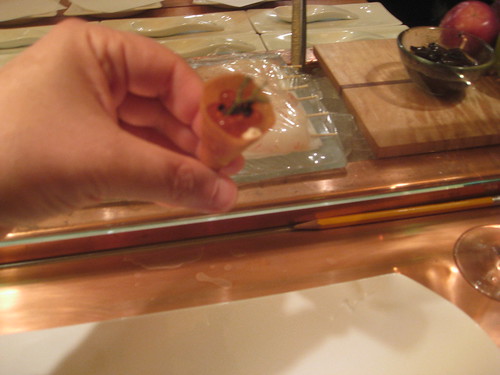
Boneless Curried Chicken Wing
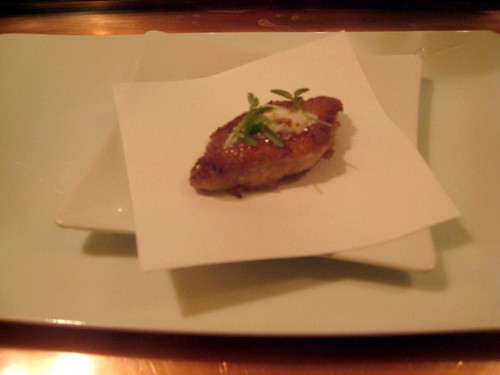
Flourless Blue Cheese and Almond Tart

"Ferrero Rocher" - savory hazelnut and blue cheese

Mojito Bubble
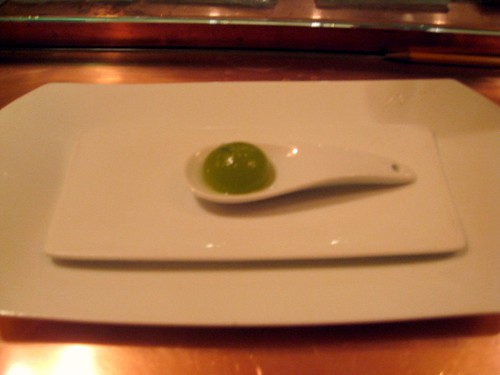
Steamed Brioche With Caviar

Brussels Sprout Tempura Rose
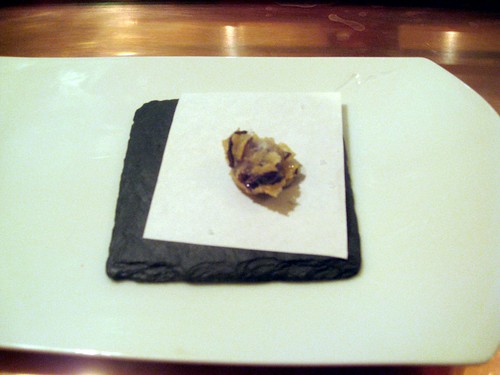
Dragon's Breath Popcorn
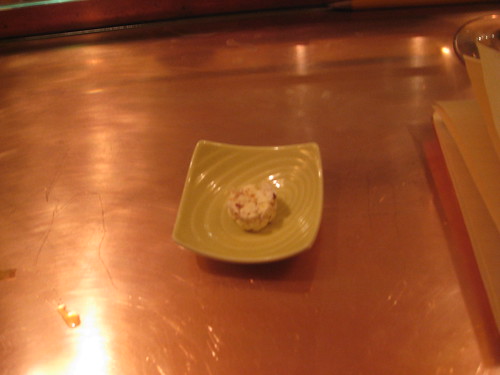
Guacamole Roll

Smoked Oyster with Green Apple
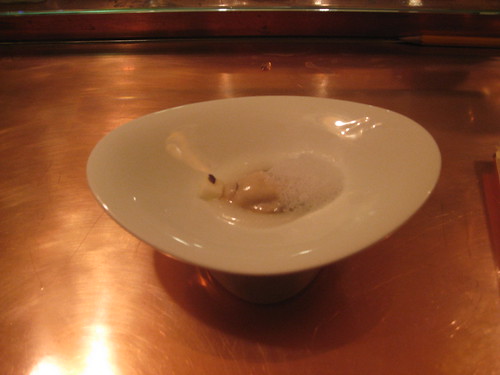
Hand Made Corn with Huitlacoche
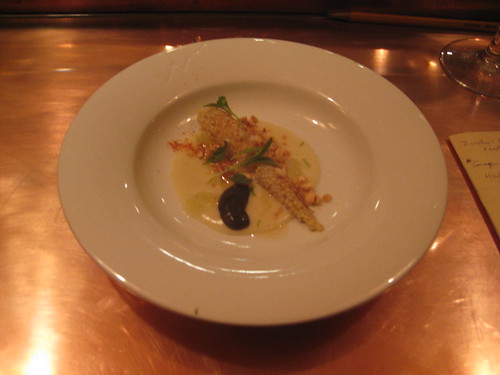
"Sun-Dried" Tomato Salad with Lemon Foam
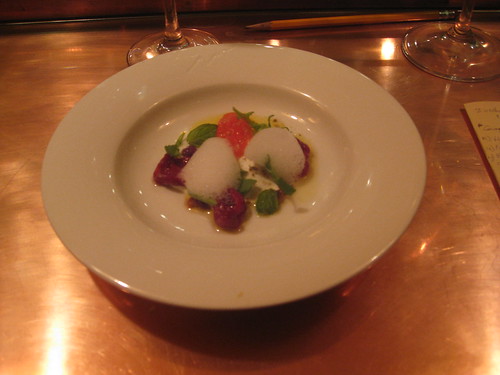
Charcoal Salmon Toro with Black Garlic and Lemon-Lime Pearls
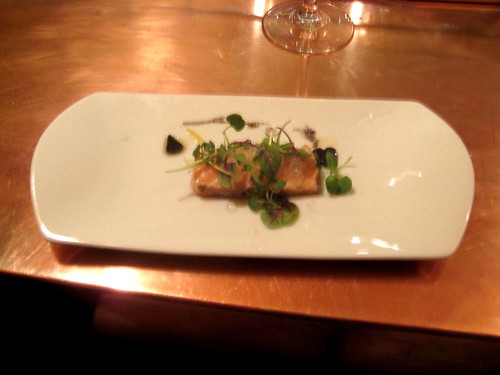
New England Clam Chowder with Bacon Cream and Potato Bits
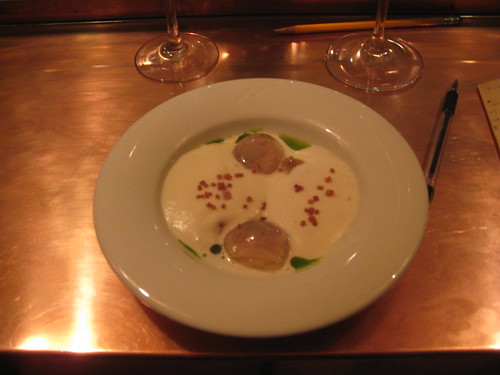
Parmesan "Egg" with Migas
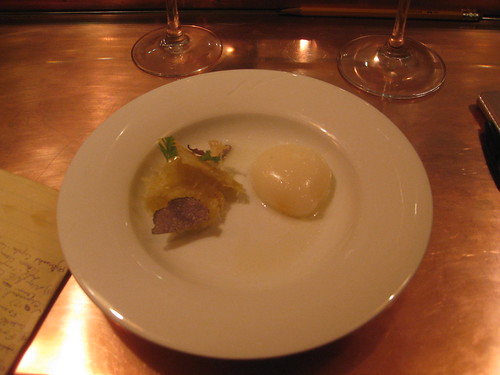
Philly Cheesesteak
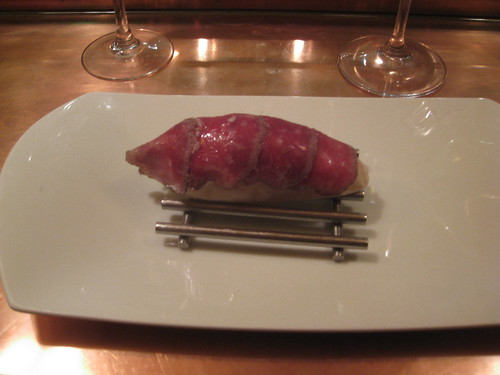
Frozen Yogurt, Honey, Olive Oil
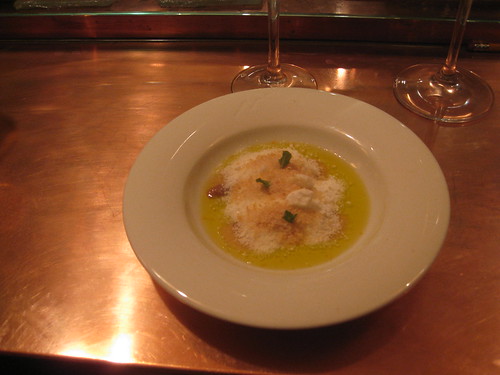
Mango White Chocolate Box, Smores, Bacon and Chocolate
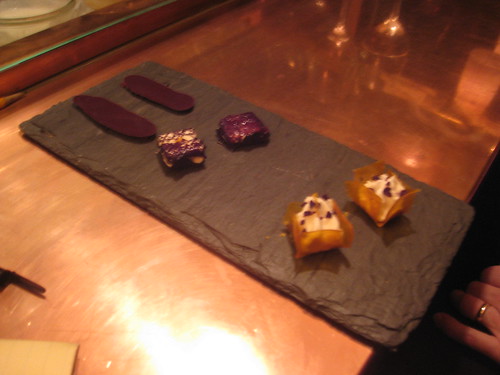
Fizzy Ball
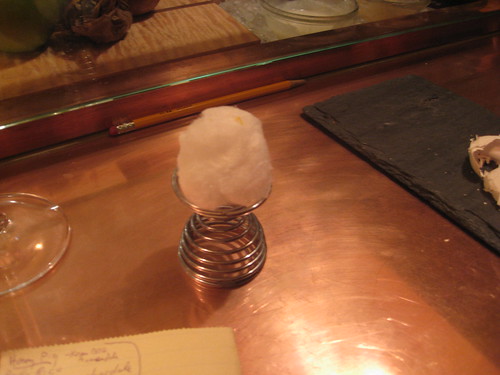
Minibar
Second Floor
405 8th Street NW,
Washington, DC 20004
(202) 393-0812
-
Two Meals – Chez Panisse and The French Laundry – Berkeley and Yountville, California
Although New York often thinks of herself as the origin of all things, such hubris ignores the reality that Gotham’s skill is as arbiter: to pick and choose among the worthy green shoots and then convince herself that they were to be found in New York all along. All the arts know this trick: Manhattan always trumps regional genius in its own imagination.
Nowhere is this more true than in gastroland: Nuevo-Caribbean cuisine from mango Miami, molecular cuisine from Barcelona and Chicago, New Orleans haute-cajun, and the list continues. But perhaps when the final history of cuisine is Kindled no patch of land will deserve more credit for culinary innovations than the Bay Area, the engine of American gastronomic theory and practice.
In a recent trip to San Francisco, I dined at two canonical restaurants: Chez Panisse (for the third time) and the French Laundry (as a FL virgin, but having eaten at Per Se three times). I also had a fine meal at Restaurant Gary Danko, but as Danko is “only” a fine rendition of well-established national trends in modern American cuisine I won’t discuss Chef D’s efforts.
Diners have their own emotional equations. A lover of the Chez Panisse might sniff at the French Laundry and the reverse. I lay my cards on the table. I have long respected Chez Panisse but never loved her (not in 1985, not in 1995, and not in 2009). Yes, I celebrate CP’s importance in birthing restaurants that I love. I recognize CP’s importance as a social movement in changing (for the better, mostly) how Americans think about food production and dining including by White House compost pile, but I have never had a “wow” moment. Leaving CP I have felt, “Gosh, this is flawless; where can I find a really good taco”? In contrast, Per Se and, now, French Laundry are me. I am in love. And if only they would use fewer quotation marks on their menu, saving gallons of imported ink, I would lack quibbles.
Despite the fact that Chez Panisse famously developed from the hippy-dippy movements of the 1960s, Panisse seems less Aquarian than Calvinist. Stripped down, lean, and clean; like dining in a Presbyterian chapel. Throwing out the capital-G gourmet frou-frou is valid to a point: it is about the food. But it is also about the show, about the excess, about the awakenings, about the ability to astonish. In Keller’s haute-farmhouse there is magic afoot.
Chez Panisse changes the menu each night. This is an impressive feat. Applause. But since diners do not eat there every night, they take their chances. Some dishes click loudly; others more softly; and few are discordant. These constantly shifting, micro-seasonal menus mean that chefs cannot perfect dishes over time, and they cannot routinely present their brilliancies. Even a chef like Alice Waters and her cooks aren’t geniuses every evening. Even Einstein needs a break. As a result provenance and produce replace art. So it was on the evening of August 11, 2009. A review from August 12th, much less December 12th could be quite different. Dinners differ by day of the week, just like New York Times crosswords – Monday is simple, Friday and Saturday more extensive. CP can duck criticism because the failed dish may never be seen again. (Playwright Suzi-Lori Parks attempted to write and then have theaters produce a play for each day of the year. Not surprisingly some were clunkers for which audiences laid down their cash).
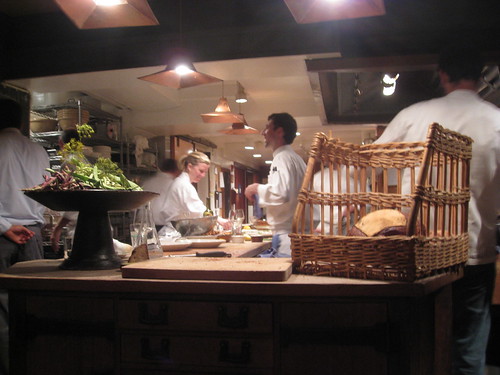
On Tuesday August 11th, we began with a chilled tomato and cucumber soup with avocado. It was an August 11th soup. Not exactly gazpacho in that the ingredients were present for our gaze: showing off a garden-fresh ideology. This was as delightful as any a cold vegetable soup that I have tasted. It was plated to remind the diner of just how fortunate they were to be served this kind of produce. Fundamentally it was not so very different from a soup that I might have made if I had such a network of gifted farmers.
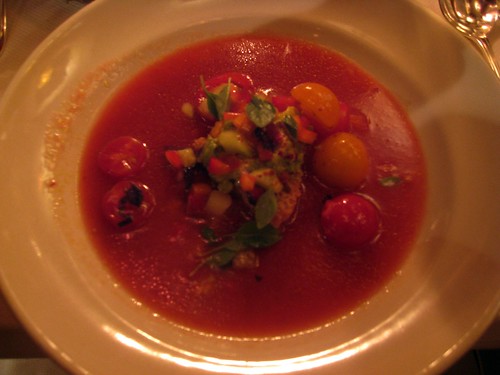
The second course was a local petrale sole à la ciboulette (chives). What simple perfection! Sauteed, lightly battered, a mild lemon sauce, sprinked with chives. What is not to like? This is the kind of dish that is Chez Panisse to the core. How hard can it be to cook sole – but flawless? Despite (or because of?) its Puritanism, its lack of show, it was the high point of the night.
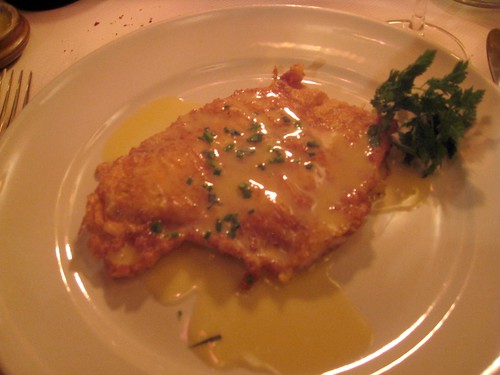
The next dish, however, revealed CP’s limits. I admit that the main courses on Monday, Thursday, and Friday sounded enticing, but this was Tuesday: Spit-roasted Becker Lane Ranch pork loin with fresh summer shell beans and chanterelle mushrooms. I have never had a poorly made dish on Shattuck Avenue and this was no exception. However, despite the quality of the pork and beans (not deconstructed, but simply shared), it had no depth of flavor (although the onion rings certainly were applause-worthy). It lacked savory memory.
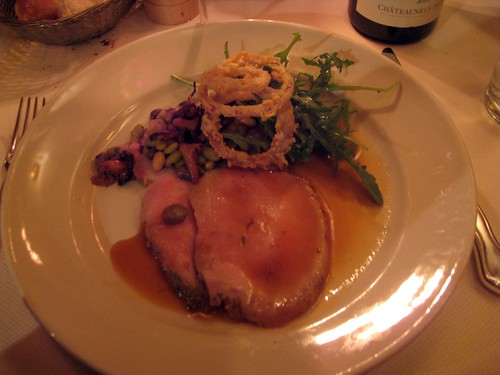
Dessert was Middleton Gardens raspberry ice cream crêpes. They were as advertised if you treat the excellent peaches and blackberries as lagniappe. At Chez Panisse, the ingredients are generous. Think of a raspberry crepe, and then think of a raspberry crepe with perfect fruit. That is Chez Panisse.

The idea of Chez Panisse is transformative, but unlike the greatest meals in my life, the food isn’t. Still, we must consider price. Turning to The French Laundry and its fireworks means traversing from a $75 prix fixe without service to one set at $240 (service included). For two icons in these days of economic meltdown, that is not a difference to be ignored. Berkeley profs can afford Chez P.
But forget cost if you can. Eat until the trust fund is no more. While Chez Panisse advertises the idea of local dining, on the following night (August 12th for the record) I tried to discern differences between French Laundry’s menu and that of Per Se. Different spaces but similar vision. While the ingredients – particularly the produce – are likely to be differently sourced and each restaurant has its own chef de cuisine (Timothy Hollingsworth at FL and Jonathan Benno at PS, although the restaurants are in continual video communication), similarities outweigh differences, beginning with Keller’s signature “Oysters and Pearls” – a “Sabayon” of pearl tapioca with Island Creek oysters and white sturgeon caviar. The dish is as definitive as ever: the great post-modern classic. (Amuses were an ethereal Gruyere gougere and a cornet of Scotch salmon, spring onion crème fraiche and a nicely spicy black pepper tuile.)

The menu at French Laundry is largely fixed, although diners choose between the Chef’s Tasting Menu and the Tasting of Vegetables (neither vegetarian nor kosher, as FL announces Lobster Bouillon and Ibérico Ham on this menu). Within the nine-course menu, diners can choose from a pair of selections for four courses (and can choose the occasion course from the other menu).
The first post-O&P course was an astonishing salad of compressed melon (a dish selected from the vegetable tasting menu) with Niçoise olives, charred scallions, arugula and verbena “aigre-doux” (sour/sweet). Of all of the skills of Keller’s minions, the composition of the dishes is unique. It is not that Keller produces the most beautiful plates or the most architectural, but his are the plates in which the placement of ingredients reveals exquisite sensitivity towards the inventive power of shape.
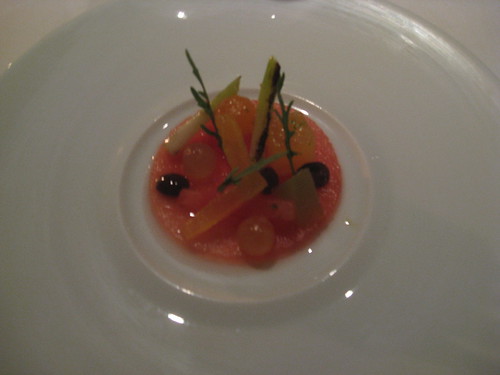
My companion selected a degustation of French Laundry garden potatoes with Australian black truffles, picked pearl onions, celery branch, nasturtium and crème fraiche. While the presentation was deliberately minimalist, one could not fault the Panisse-like quality of ingredients while also recognizing a distinct combination of tastes.

The first fish course was a flavor-confection centered around Chesapeake Bay soft-shell crabs with marinated eggplant, pleasantly bitterly pungent red radishes, navel orange pips, mizuna, and miso vinaigrette. I was entranced by this careful composition. This was another favorite dish in a list of favorites. There is a sculptural intensity that characterizes Chef Keller’s presentations, but also an intensity of flavor: a wisdom that recognized that crab, radish, oranges, and eggplant might make for a perfect Wednesday evening.
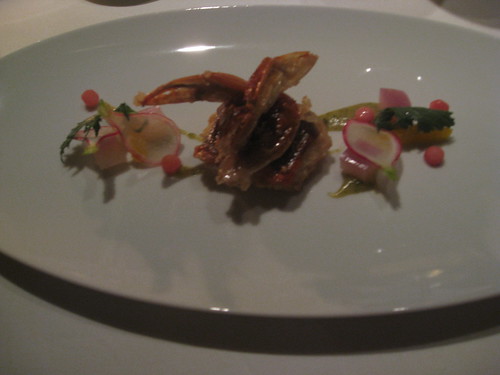
The other fish dish, sautéed fillet of Columbia River sturgeon with “pain de Campagne,” toybox tomatoes, little gem lettuces, Spanish capers, and “bottarga di muggine,” reveled a fillet a little more cooked than perhaps it ought and with a somewhat minimalist background. I found this the least compelling plate of the night. It didn’t sing or zing.
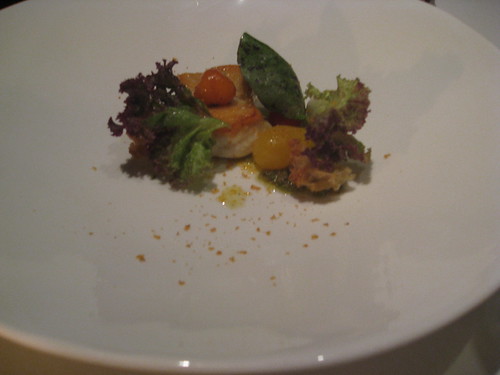
Maine lobster tail “pochée au beurre doux” with mission figs, Cipollini onions, scallions, and chocolate-coffee sauce was heroic with the unlikely but stirring partnership of buttery lobster and choco-coffee. Consuming this shellfish reminded me of watching Hamlet performed in rap: we know the traditional text and can enjoy how modernity plays tribute to tradition.

We had two choices for the first meat course: Salmon Creek Farms Pork Belly with Savoy spinach, chick (or chic!) peas, spicy paprika, and Meyer lemon condiment worked hard to please. My photo does not do the dish justice, but this was the night’s least photogenic plate. Still, the richly tart lemon made for a very nice counterpoint to the fatty, deep pork. A very satisfying dish, even if short of astonishing.
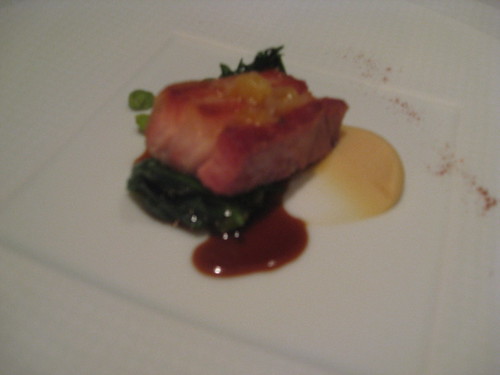
The second option was preferable: a gemlike combination of “épaule (shoulder) de lapin farcie aux ris de veau with Jacobsen’s Farm Pears, hazelnuts, watercress and summer truffles. A brief editorial: Why provenance the pears? Does knowing that they were reared by some farmer in the dell’s orchard improve my pleasure? True, all pears, even American ones, are not created equal, but wouldn’t the variety of pear be more important than their human parent. End of rant. And back to this treasured dish with its wonderful August truffle and oh-so-sweetbreads. With its novel utensil this was the dish most reminiscent of Alinea, but wherever FL’s inspiration, it was inspired.
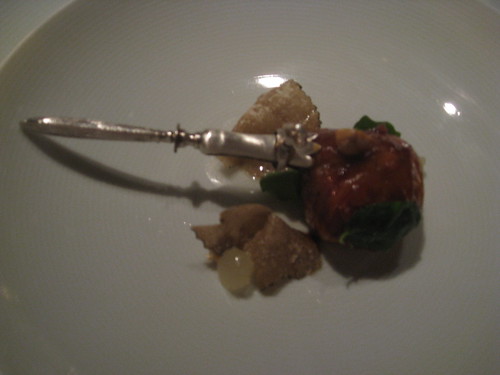
The menu’s centerpiece was Snake River Farms “Calotte de Boeuf (an often ignored cut of beef surrounding the ribeye) Grillée” with globe artichokes, Nantes carrots, garlic “croquante,” parsley shoots and sauce barigoule, a sauce traditionally napping artichokes, a nod to classical cuisine. This was not an exotic adventure, but a dish with enormous integrity. Not as simple in presentation as dishes at Chez Panisse, it evinced equal respect for produce. Minimalist, each bit was revealing. Of all the courses in this evening of pleasures the honest grilled beef demonstrated the long and warm shadow of Alice Waters. Without her brave fight, the French Laundry could never be.
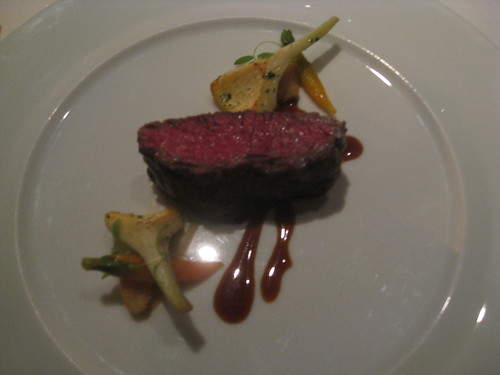
Our cheese course was “Tomme du Berger” (a soft, nutty, “fragrant” cheese) with hen-of-the-woods mushrooms, sweet peppers, haricots verts, and arugula. It was an ideal follow-up to the beef. This was another quiet, intense course that bowed to the integrity of the ingredients. One does not need a plate of cheeses to conclude: cheese matters.
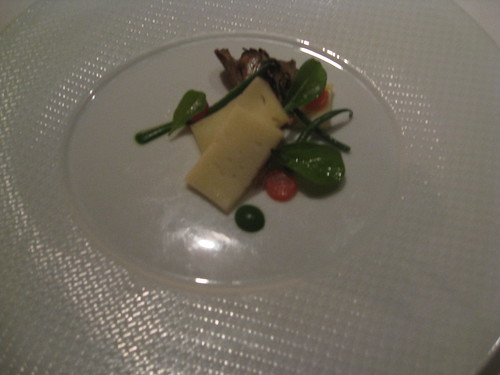
Honeydew melon sorbet with compressed red and yellow sorbet and basil “nuage” (a “cloud” or light foam) reprised the early melon dish. It was a very pleasant palate cleanser.
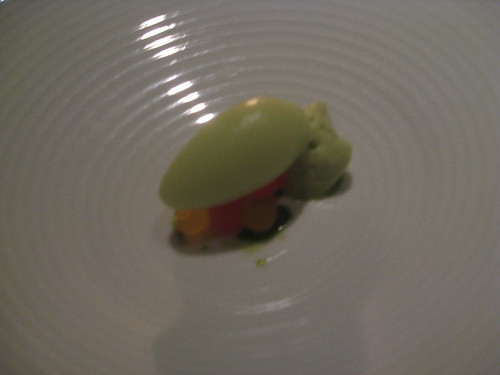
For dessert my companion ordered the “Ballon de Chocolate Fumé” with smoked black tea, vanilla ice cream and tonka bean caramel. He was presented with a chocolatty bocce ball. My small taste suggested a Cadillac of sundaes.
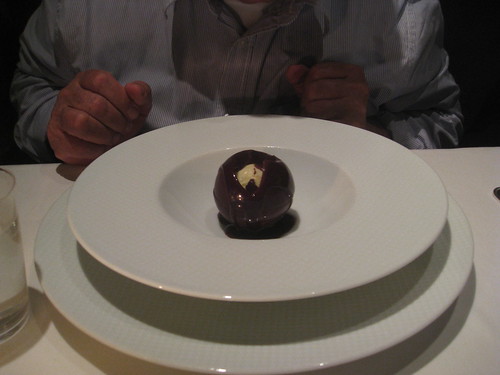
I decided upon lemon verbena “vacherin” (a meringue base) with Tellicherry pepper panna cotta, lemon verbena sherbet, and chilled Silverado Trail strawberry consommé. This composition was another favorite with clever shapes, vivid colors, surprising textures, and sensuous tastes. This sweet revealed a complexity that announced that whatever the debt of Chef Keller to Chef Waters, his cuisine is more challenging and remarkable in its visionary potential. Keller’s vacherin was a splendid closing to edge me into the cool, still, verdant, small-town Yountville night.
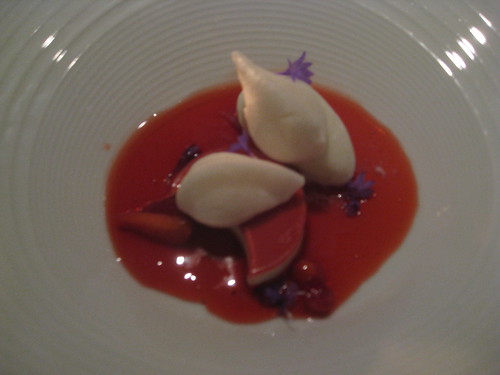
Service at both restaurants was warm in a way that only Californians have perfected.
Eating at Chez Panisse and French Laundry back-to-back is a one-two punch that might only be matched by consecutive meals at L’Arpege and El Bulli – but these Californians sit just across the bay. Cali rulz.
Chez Panisse
1517 Shattuck Avenue
Berkeley, CA
510-548-5525
The French Laundry
6640 Washington Street
Yountville, CA
707-944-2380
-
Breather - Greens - San Francisco
After a hectic culinary week in San Francisco, it was time for a last lunch. So many choices, so little time. Before heading off to a four-hour flight in a sardine tin, I needed some mellowing out. And in the Bay Area, Greens marries bliss with upstanding cuisine. One realizes the possibilities of a robust and creative vegetarian cuisine while relaxing at the edge of the Bay. Greens captures the ethical soul of near-fine dining. This is no veggie-shack, but green cuisine.
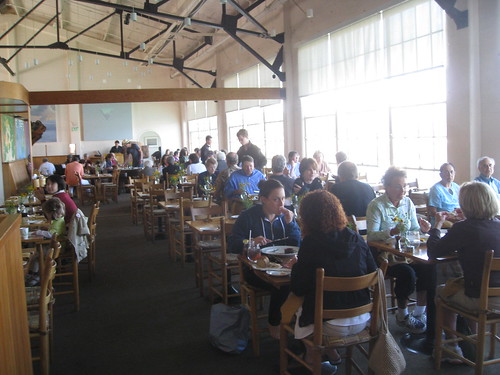
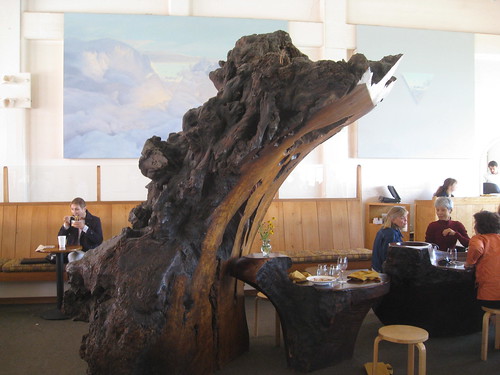
Having had a warm bath of calories the past week, I chose two cool and light plates. Both were generous – and humane – first courses. Grilled nectarines with fromage blanc, watercress, and Snyders sage honey was as tempting as any fruit salad that I have been served in, well, close to ever. It was summer sweet while the crunchy watercress added a slight peppery intrigue. Perhaps it could have been dessert given the honeyed depth, but for a small meal it was a fine starter.

The second plate was ricotta corn cakes with jalapenos, scallions, cheddar and smoked cheese, served with crème fraise, fire roasted tomato and pumpkin seed cilantro salsa. The ingredient list on the menu makes the dish sound more pretentious than it was in person, but those allergic to pumpkin seeds and smoked cheese have been duly warned. These griddle cakes were a fine success, reminding us that (pace Michael Pollan) corn is not necessarily a four-letter word. These cobby-blinis were complex without being precious. Had I the stomach I could have eaten a baker’s dozen.
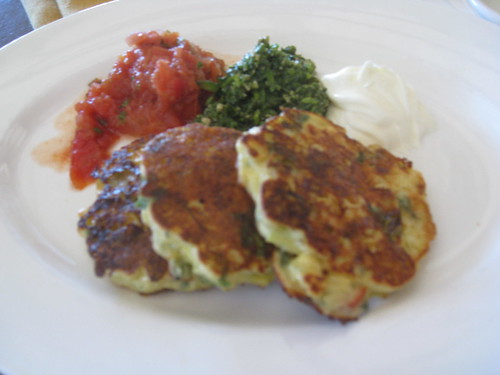
And so from the bustling calm of Fort Mason, I left with memories to consume on the (thankfully) foodless flight home.
Greens
Fort Mason, Building A
San Francisco
415-771-6222
-
Since I am writing about Highlands, I should note that Chef Broyles (of the Frog and Owl Cafe) is no longer at the Oak Street Inn (and long gone from the so-so Frog and Owl Bistro). She was there for a year, and I am told that as of last year was working for a sandwich shop in Franklin. If true, what a waste of talent!
-
Madison's (Old Edwards Inn) - Highlands, North Carolina
About five years ago, the Old Edwards Inn in Highlands was renovated, transformed into a four-star (or five-star or however many stars mean really, really fancy and) inn, resort and spa. In the course of this transformation from an old-timey inn on Main Street, they opened a fine dining restaurant, Madison's. In its first iteration it attempted (somewhat bizarrely, and without much grace) to borrow from molecular cuisine and also incorporate a set of rather bizarre flavor combinations. Different is not always better. Back then the restaurant was rather too taken with itself, and my first meal was not a success - quite the contrary with a check that suggested that the owners felt that the food was more sparkling that it was.
However, over the past two years, I have had several improved meals at Madison's, culminating with an excellent dinner last night. The chef de cuisine (at the restaurant for two years now and now in charge of the menu) is Chris Huerta, who worked with Guenter Seeger in Atlanta (at Seeger's, which, until it closed in 2006, was Atlanta's premier restaurant - Seeger is attempting to open a New York restaurant) and who was a stage at Per Se. Huerta is a serious young cook with a serious blog ("Chipped China"). My friends and I were very pleased with the style and assuredness our meal. In strictly culinary terms Madison's is - by some distance - the most accomplished restaurant in the area (go to On the Verandah for the view and good food). Madison's has a quite pretty space and in contrast to some area restaurants is light and airy and is relatively quiet. They also have an ideology of "Farm to Table Dining," which they are expanding - mostly vegetables and pork at this point.
I began with Huerta's Apple and Bacon Hushpuppies (ah! bacon!), which were the best hushpuppies I have ever eaten. Granted claiming that one found the world's best hushpuppies may be akin to picking low-hanging fruit, but they were delicious. A friend had a very creamy (and nicely composed) vidalia onion soup and another companion had a salad of Chilled Local Carolina Shrimp Salad, Florida Citrus, Winter Greens, and Vanilla Citrus Double Cream. Let us ignore the "local" shrimp as we are several hundred miles from the sea in the western Carolina mountains, but the Vanilla Citrus Double Cream was a very becoming complement to the fresh shrimp.
For entree I chose the compelling (although not visually remarkable - unless one likes a symphony of gray and brown) Braised Duck Leg, Celery Root Ravioli, and Stewed Hand Harvested Mushrooms with Natural Jus. It was a luscious combination with perfectly moist duck leg and properly cooked ravioli with its intriguing celery root stuffing. If not quite worth a photo, it was the most polished entree I have had in these mountains since the grand Frog and Owl closed fifteen years ago.
Dessert was an assured smooth vanilla-bean panna cotta with butterscotch sauce and crumbled espresso biscotti and a cornet of vanilla bean (I think) ice cream. Another appealing and modern presentation with a mix of flavors that were delightful, if not quite startling.
Madison's also has an extensive wine list and well-selected wines by the glass.
But for one who spends a month in the mountains each summer, Madison's poses a problem. Should every dinner out be a dinner at Madison's. Is everything else just slumming?
Madison's
Old Edwards Inn
Fourth and Main Street
Highland, North Carolina
866-526-8008 or 828-526-8008
-
Grump - Selene – Santorini, Greece
When it comes to restaurants, I can be a bit of a grump. My standard is perfection, and even I can’t meet that standard! Recently my wife and I took a cruise through the azure waters of the Aegean Sea. Now cruiseship food – even if bountiful, colorful, and well-provisioned - can not salve a culinary grump. But every so often we escaped the ship. One of these moments permitted us to explore the beautiful, white-washed island of Santorini, an island formed from the rim of a volcano, which the deity exploded for His own amusement (Santorini sits in a caldera – the collapse of land after a volcanic eruption), the most remarkable spot in the Cyclades. When one comes across a crescent sliver of land so exquisite my thoughts turn to, well, food. (My thoughts also turn to food when viewing a toxic dump or a beautiful woman.)
Still, Santorini is more than brownfields or lithesome legs, it is scenic. Were this insufficient, Santorini is also the home to one of the most astonishing restaurants in all of Greece, and, Michelin not to the contrary, in all the EU. Selene, perched on a cliff in Fira, the main town (in fairness most of Fira is perched on a cliff), opened in 1986 under the guidance of owner George Haziyannakis, who wished to show off the creative nature of Greek cuisine. He succeeded.
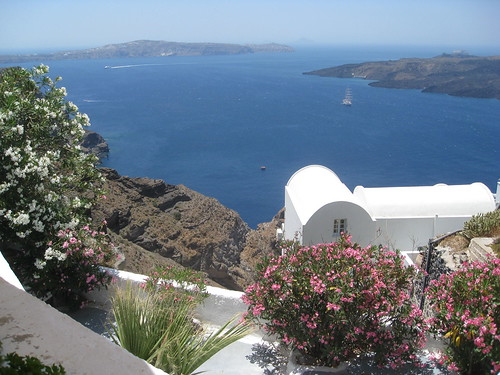
Yes, the view is perfection, but it cannot quite compete with the food. One looks down at one’s plate while the clouds and skiffs pass outside. We began with a pair of soups, cold tomato and warm rockfish and langoustine. The cool tomato was perfection in this warm June lunchtime, although had this been our only course I would have noted Selene as a most pleasant boite. The seafood soup was pure cream and sea: impeccably rich and sweet, with ingredients that revealed that locavores have a point.
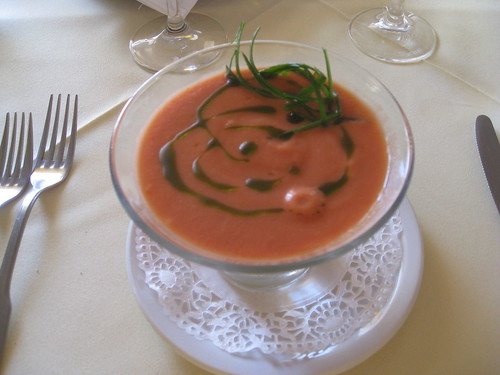
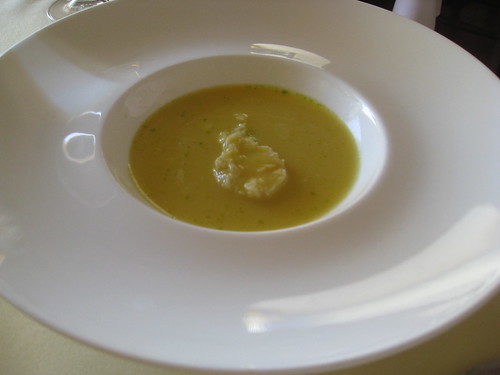
These soups were followed by an appetizer of local bivalves with lemon foam – molecular cuisine in the isles! – paired with potent seafood tartlets. Here was a chef who was aware of both the standards of modern cuisine and the robust cookery of the Aegean. Again the local clams were salty-fresh and the buttery tarts composed of the finest catch of the wine, dark sea.
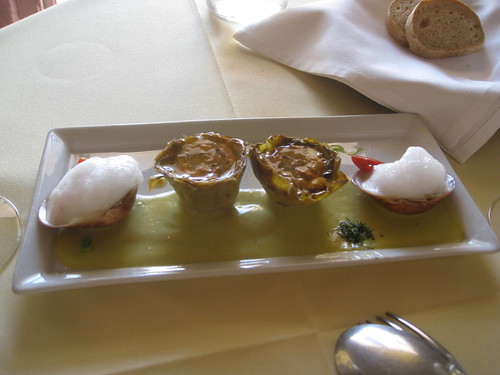
But truly it was the main course that was spectacular: that afternoon I fell in love with all things Santorini. As is clear from the photo the ravioli is not the enclosed, Italianate pocket pasta, but rolls of perfectly cooked strips with – again! – blessedly fresh seafood with plump mussels and delightful squid, so perfectly prepared that the word rubbery was banished, and authoritatively and sharply seasoned crayfish and shrimp.
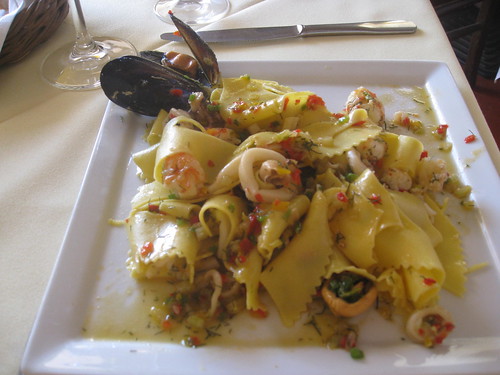
As magnificent as the ravioli was, it was surpassed (just barely!) by the risotto: rice in a fava bean sauce with a juicy roasted rabbit with an evocative rosemary jus: symphonic notes of Greek cuisine, but so expertly prepared that it would have been perfection if prepared by Escoffier. A month later I still dream of this brilliancy.
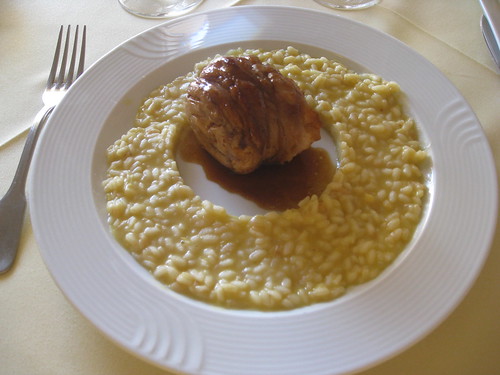
To close the afternoon, we were served a sturdy baklava with a startling Niotiko cheese ice cream. Not a showy dessert, but with the view appearing again, the dessert served its purpose.

Never have I been so pleasured by the combination of taste and scene. With God as designer and with Selene’s own divine kitchen staff, any grumpiness must quickly be voted off the island.
Selene
Fira, Santorini
+30-2286022249
-
Midsummer House – Cambridge, United Kingdom
After being prepared to admit, sadly, that there are no excellent restaurants in Cambridge, a week before my departure I had one of the outstanding meals of the year. Of course, the happy success was not a total surprise as the Midsummer House (set in a lovely garden near the banks of the River Cam) had received two Michelin stars. However, two Michelin stars have often been just enough to break one’s heart. But not this evening. Under chef Daniel Clifford the meal was nearly flawless, failing only a few minor tests.
The evening began with a tiny, but surprisingly robust gazpacho tasting, made memorable because of a wave of pureed celery that set off the acidity of the tomato base. It was delightful, and would have made a worthy bowl on a summer evening. This was followed with a simple and creative anchovy tempura – just enough fat and salt to make every health care vanish. It was unfortunate that these starters were pared with the only real failure of the evening: two cheese (brie?) gougeres that were overfilled and lacking interest.
Still working through the amuses, I was presented with a crystal ball filled with pink grapefruit cream and champagne foam. While foam is properly being edged off the gastronomic stage – having had its fifteen minutes of culinary fame – foamy champagne was a novel and witty retort. It was a memorable palate cleanser before my palete needed to be cleansed.
This was followed by still another amuse: a sweetpea veloute served with tiger shrimp. If not as creative as the remainder of the meal, it was silky smooth and the essence of an English spring.
Finally we reached the meal itself, which without being experimental, captured the best and brightest of modern European cuisine. The ingredients, of which there were many, blended in inspired and startling ways, and, in fact, I was profoundly grateful that I avoided the tasting menu so that I could enjoy these plates in full.
As my appetizer, I selected maple-caramelized sweetbreads with turnip, pistachio, ox tongue (!), and maple jelly. Although such as dish had danger of being an early, cloying dessert, the sweetness was mellow and added a complexity and richness to the subtlety of the rest of the ingredients, rather than overpowering them.
As a main course, I selected braised turbot with peanuts and pistachios (this turned out to be an all-pistachio dinner), sea scallops, cos lettuce, asparagus in a crackly pastry, and vanilla. While I would have preferred my fish to be more translucent, such is rarely how fish is served in the British Isles, and the fish was in no way overdone (even if such cooking involves dancing on a tightrope). The remainder of the plate was splendid, and complemented the mild white fish to excellent effect. Chef Clifford is particularly to be commended in his attention to texture.
I passed on an extra dessert – a tiramisu – too much caffeine: but it was a beautiful display.
Finally a triumphant close: warm braised cherries with pistachio (again!) ice cream with a cream filled pistachio “cannelloni” shell and underneath chartreuse tagliatelle. Perhaps the meal was dominated by nutty tastes, but they were remarkably sophisticated with the herbal echoes of chartreuse as a counterpoint.
The Midsummer House deserves attention and not only in the long evenings of June. The location and size of the restaurant militates against a third Michelin star (it is not really in position to be a “destination” restaurant), but I have no hesitation in preferring it over two London standards The Square or Marcus Wareing at the Berkeley, and, if not as creative as Gordon Ramsay or The Fat Duck, capable of equaling them in pleasure and bettering them in cost.
The Midsummer House/Midsummer Common/ Cambridge, United Kingdom/+44 (0)1223 369299/http://www.midsummerhouse.co.uk
Pictures to be posted later.
-
Moto 2009
Last Tuesday I returned to Moto, Chicago’s premier molecular restaurant (at least if one places Alinea in its own transcendent category), and I was surprised at the changes. The restaurant looks much the same, but the cuisine feels different. The changes at moto may mirror those decisions made by many successful artistic rebels. After their moment of publicized rebellion – after they have thrown down the gauntlet and after the media has chronicled that gauntlet – the rebel needs to ask, “what now?” These heroes come to realize that there is a lot to be learned from the standards of the world from which they have rebelled. Perhaps symbolically when we were given our kitchen tour we did not need to wear protective googles – there was no laser in evidence.
Strikingly, the dish from the ten-course dinner (with a few extra courses) that I remember most clearly and most fondly is (almost) a dish that could easily have been served at any restaurant committed to contemporary cuisine. The kitchen presented a pan-seared Texas quail with modulated hot (pequin) pepper and celery three ways. Granted the dish arrived with an edible paper that was reminiscent of buffalo wings – the dish was ostensibly a deconstruction of buffalo wings – but what struck me was how sweet and luscious and even traditional the quail was. My tablemates agreed. The “Chicago steak dinner” was likewise a lovely, modernist dish with a beautifully cooked bit of prime rib eye. Yes, it was a deconstruction of the composition of such a dinner, but not a destruction of it. Perhaps the least effective was the faux “breakfast” – a coconut and passion fruit egg (white and yolk) served with crab cake tater tots and blood orange ketchen. The crab was extremely tasty, but the egg (a borrowing, if I recall correctly, from WD-50) was more curious than enjoyable, given a texture that was perhaps too reminiscent of plastic.
As with this “egg” dish, some of the Moto oddities – the powders and a little nitro and a Cuban sandwich shaped as a cigar with ash, but for the most part the tastes were strong. There were no dipping dots to be seen. Moto’s problem has been that the concept has on occasion overwhelmed the taste. The edible menu (as the amuse) is a case in point. No one would demand to eat this cracker were it not for the jest on which it is based (eating the menu).
Pastry Chef Ben Roche’s desserts were, as usual, most enjoyable, but not so different in spirit from what one might be served as Jean-Georges, Per Se, or, in Chicago, at Blackbird. They were compositions of flavor points, following modern canons, rather than provocations. And they were all the better for that.
Moto 2009 reveals a greater attention to flavor, while sometimes the presentation seems to be minimalist (such as the BBQ beans and slaw. The roadkill (described on the menu as “roadkill of fowl”), a now canonical dish at moto (a result of the visit I organized when the restaurant had first opened) is based on duck (not raccoon) and is much more elaborately plated. However, while the dish is tasty, it has lost some of its authenticity as a just-in-time creation.
So moto is changing, as it should be. Chef Homero Cantu seems to be considering what he needs to do, rather than what he can do. After all, if it is only the ideas that matter, what would justify return visits? Moto remains vital and exciting, clever and tasty: but now a restaurant that doesn’t need to strain so hard to be worthy of its diners’ love.
Moto's edible menu (Grand Tasting Menu version)
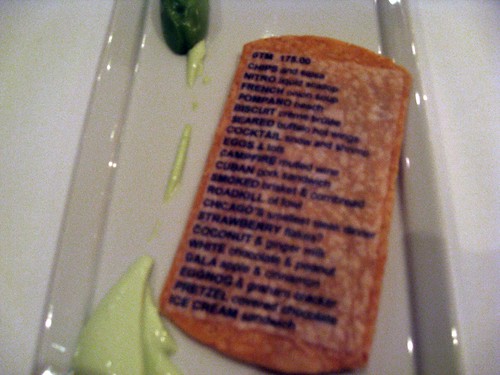
Passion fruit and coconut egg with crab tater tots and blood orange ketchup

Saffron Scallop with Lemon oil power, Orange and Shiso syrup

Deconstructed French onion soup: Gruyere and onion cracker

House made pequin (chili) quail with trio of celery

Smoked beef brisket, frozen cole slaw, and BBQ beans

Roadkill of fowl: duck, red and yellow beets, crunchy red rice
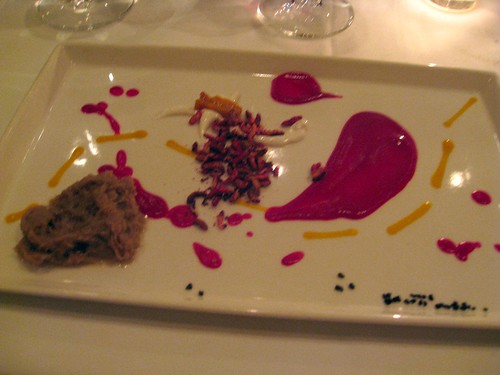
Chicago Steak Dinner

Pina Colada forms for dessert
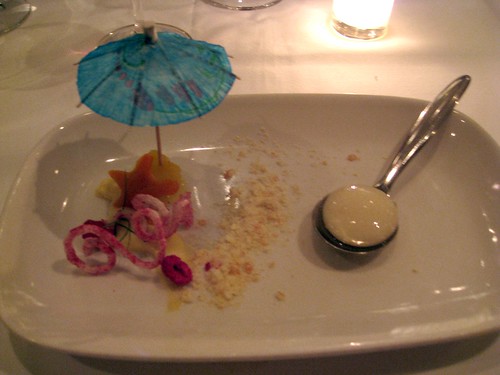
Pumpkin pie forms for dessert
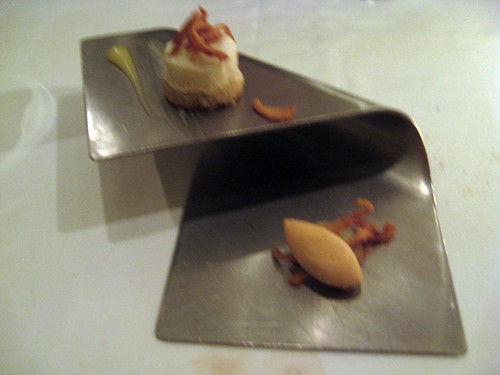
Moto
945 West Fulton Market Street (West Loop)
Chicago
312-491-0058
-
Spanish Panache - Cinc Sentits – Barcelona
How can so many svelte women be on display in Barcelona? Don’t they know that four star dining abounds. Surely they must because they are to be found at those tables, but there must be a caloric catch somewhere. So much taste, so much elegance, so little time. Among these choices none is better than Cinc Sentits – a brilliant establishment that revels in the five senses (the soundtrack included Frank Sinatra, Tony Bennett, and Dean Martin - a pack of rats in a clean, cool trap). Of my meals within the boundaries of Barcelona, the finest meal was that splendid lunch at Cinc Sentits, a temple of light near the University of Barcelona. Cinc Sentits is a college of the senses.
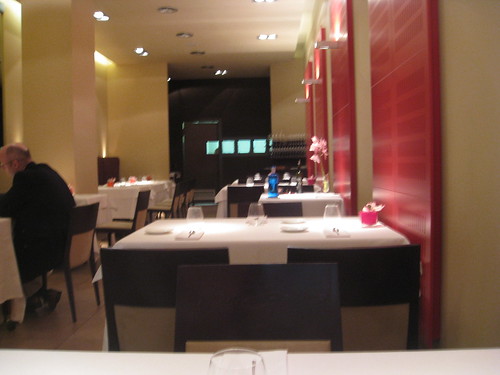
I began with one of the most compelling and thrilling starters in recent memory: a shot glass filled with drama and with love: cava, cream, and maple syrup with a little salt as accompaniment: all of the passionate food groups were here: champagne, cream, sugar, and salt in a jewel-like composition. I was dazzled by the light.
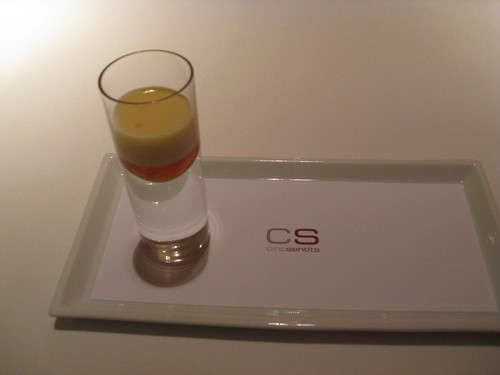
A second, deeper starter was a tomato ice compote served with a slice of sausage, garlic foam, and small bread cubes: gazpacho deconstructed. The presentation was exquisitely composed and a cool counterpart to the hot streets of a waning Barcelona summer. By forcing the diner to contemplate the construction of gazpacho, it did what majestic modernist cuisine must do: to turn food into theory, while keeping it at the peak of delight.
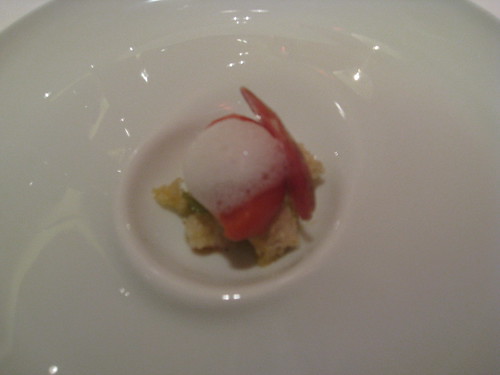
Then followed a squat square of foie gras: a cube of liver with an elegant and rich pasty layer beneath and a crispy burnt sugar crust above. Like so many such dishes it might have overplayed a desire to transform foie into dessert, but what saved the dish from a sugary mass was the subtle play of textures throughout, as fetching as a rectangular crème brulee.

The seafood plate was a perfect rectangle of tuna in a smoked tomato water with a roasted onion “sofregit” (a tomato-onion-olive oil sauce) and black olive salt (Cinc Sentits is partial salt as a condiment). Perhaps tomato water represents the ultimate downsizing of French saucing, but such lightness makes one feel healthy, forgetting the calories elsewhere (The secret of Spanish beauties). If not as filled with drama as the amuse, it was a subtle, slinky dish.

Iberian suckling pig was the last in a trio of rectangular cuisine. Fatter and denser than what had been previously presented, this sous-vide pork – perhaps slightly mushy as served - wallowed in its richness, swathed in a crispy ratafia glaze (a fruit cordial) and sprinkled with (more) salt. The texture was a bit off, but the taste was dense and complex and precisely porcine. To recapitulate the lifeworld of a Spanish sow, apples served as the accompaniment: in cooked slices and as an apple jam with wine and honey.
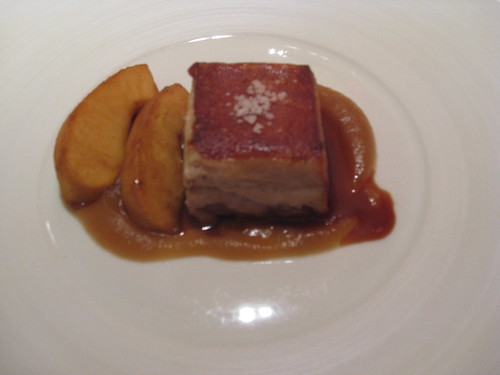
Dessert was a plentiful plate of gloriously zesty Maresme strawberries (an area on the coast of Catalonia known for these ruby berries). On top sat a scoop of marscapone sorbet with some fennel and rose water. One can not term this combination “simple;” splendid is more precise. Airy, herbal, flowered, and divine.
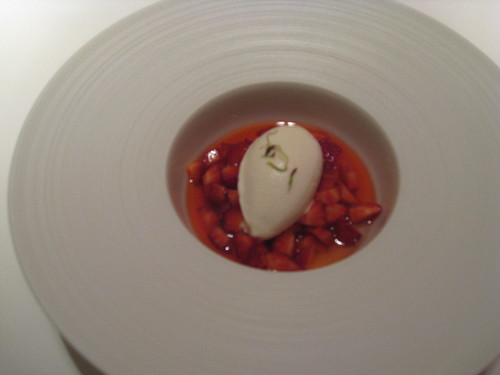
Cinc Sentits is a restaurant for the five senses. By no means the most expensive restaurant within town limits, of my dozen meals this was the pinnacle. Cinc Sentits is Catalan splendor on high heels.
Cinc Sentits
Aribau 58 (Eixample)
Barcelona
93-323-9490
-
L2.0, Someday *** L2O *** Chicago
The question constantly abuzz is what is the next new thing, and this summer in Chicago fine dining circles, it appeared that San Francisco Chef Laurent Gras’s new seafood restaurant (in the Ambria space), part of the Lettuce Entertain You Group (now 38 restaurants strong, including Everest) might be that place. Chicago, in truth, does not have a four-star restaurant, like Le Bernardin, that specializes in the aquatic. It still doesn’t.
To review L2O is to calibrate. Chef Gras’s establishment is by no means a failure. They have a superior seafood supplier, the fish is served without fault, and one of the dishes (of four, plus two amuses) is stellar. (Many of those who have raved about L2O indulged in the tasting menu; for our late dinner, we selected the workingman’s four course repast: the Goldman Sachs blue plates special). L2O does not have a poor record, except in competition with Alinea, Trotter, Tru, Avenues, or Everest.
What constitutes four-star dining? Surely decor matters, and I was startled at the casualness of the dining room (it is decorated in tones of cream and brown, reminding me of a suburban corporate lounge. It lacked astonishment). With the exception of a wonderfully complex and evocative sculpture of branches in the entrance (providing Japanese notes, also seen on the menu), the space itself is rather conventional (table settings are impressive). This is satisfactory for a restaurant with modest aspirations, but can this space match Alinea or Everest.
A second feature is the service. At the highest caliber restaurants one blindly places oneself in the hands of consummate professionals: a wine director and skilled server. We trust nothing will go wrong. Of course, things do go wrong – and allowances must be made – but each glitch chips one’s confidence. Our server was quite congenial – friendly, warm, caring – yet, although we were told that we would be able to choose a soufflé that option was not asked when we ordered. Worse, we were not asked about wine service. Where was the sommelier? (This was a weeknight.) But whether present or not, we should not have had to inquire. And wine should not be spilled. Nothing terrible, but L2O has been open long enough for everything to settle into perfection.
And then the food. It is not surprising that L2O is at home with fish, but it is distressing that a restaurant that hopes for national recognition should fumble elsewhere. The fact that many dishes, including the dessert and cheese course is garnished with emerald crystal ice lettuce revealed either a fatal absence of imagination or a terrific deal on these greens. Although some have praised the bread service, I was less taken with the anchovy bread, which served no purpose as an accompaniment to delicate fish or as a match for sweet butter.
Our first amuse was the least engaging starter I have had in some time: had someone eaten this pseudo-molecular creation and pronounced it magnificent? Here was a peanut sponge with wasabi. Granted it was a bit like eating a sponge, but neither the peanut nor the wasabi added much in the way of taste, and the visual appeal was decidedly limited. Do I really want my chef to consider me sponge-worthy?
Better was a second amuse with tuna, tomato, olive foam, and orange gelee. It was a startling combination. The flavors were not perfectly coordinated (olive and orange are not ideal bedfellows), but the tuna was just fine, and it suggested a chef who is testing boundaries.

The four course menu is structured around a raw course, a warm course, and a main course (reminiscent of Le Bernardin), plus a dessert. My raw course was Ishidai (a type of bream, a very mild white fish) with shiso leaf, preserved lemon, trout roe, and heart of palm. The ishidai was wonderful, but it was overwhelmed by the pungency of the shiso and lemon (both wonderful tastes, but would have been better as undertones). Served in four pieces, the ingredients had to be unpacked and rearranged to be fully satisfying.
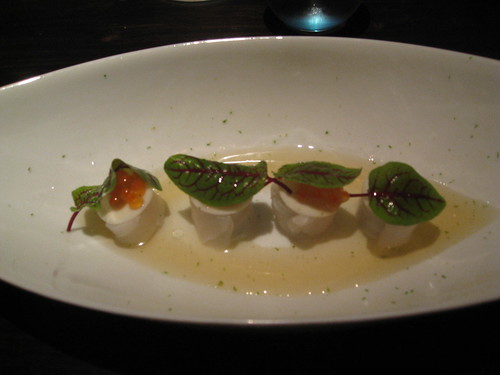
The second (warm) course was the highlight of this and many meals. A truly memorable dish: a two layered circle of lamb tartar and ebi shrimp with pickled peach and tarragon. This was a combination that could stand up to its accompaniments. It was a supremely wonderful dish – meaty in land and sea - a set of startling contrasts that forced a diner to rethink preconceptions. Sterling.
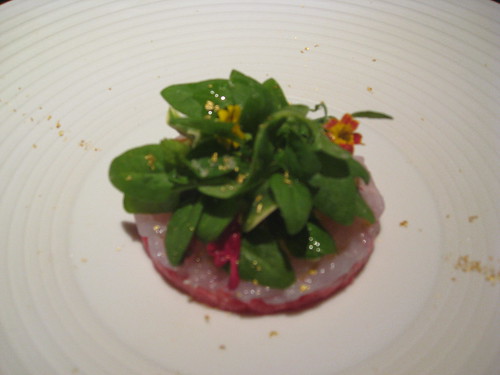
The main course was striped bass with shellfish bouillon, saffron, Rhode Island mussels, striped sorrel, and a plank of toasted brioche. The bass was perfectly prepared, the bouillon rich and complex, the mussels, fine. The board of brioche meant that any attempt to conquer this bread led to flying crumbs. It was not the most congenial dish to consume. The ingredients were well composed, but the flavors were not as remarkable as the previous course. It was a more traditional entrée. Does Chef Gras have a distinctive style? These dishes make a theme hard to find.

Finally there was dessert. Sigh. As the desserts were described, they seemed to have numerous interchangeable parts. One (unordered) choice was Chocolate and Raspberry in fourteen textures. Perhaps it was wonderful, but it seemed pretentious. My selection, with a similar number of parts, was Tomato Strawberry. Nasty. The fact that a recipe for the dish (or something similar) is on the website suggests that someone must have found a black pepper meringue to be inspirational. But is this a marriage for strawberries? Should you wish you can prepare this dessert at home, reach in your cabinet for versawhip, low acyl gellan, soy lecithin, xanthan gum, red food coloring, something called Fizzy, and, oh yes, petite emerald crystal ice lettuce. Bon appetit! Alice Waters, where are you when we need you. In contrast to the locavore crew, I am not ideologically resistant to creations from Dr. Frankenstein’s kitchen, so long as they are toothsome. This dish - a blurred mix of sweet, bitter, and peppery - was a mess. Serve durian and be done with it.

My companion ordered the cheese course. No choices and no accompaniments (jams, nuts). But nice cheese.
L2O is not without its moments. The fish is lovely and there are flashes of brilliance, and on other times moments of sheer, unalloyed pleasure (the silky bouillon). I have tried to calibrate my review to capture a restaurant that itself does not always calibrate its dishes. The check certainly indicates that Chef Gras is striving for four-star dining, but the experience itself seems at some distance from those lofty heights. And so we have L2O, waiting, perhaps, for L2.0.
L2O
2300 Lincoln Park West (Lincoln Park)
Chicago
773-868-0002
-
Sunlight Dancing * Alkimia * Barcelona
What an array of dancing sunbeams is Alkimia, Chef Jordi Vilà’s Michelin One-Star in the Eixample, not so far physically – or conceptually, perhaps – from Gaudi’s La Sagrada Familia. Here is a stylish restaurant in which taste and texture are always central. The restaurant would broadly be placed within the canons of the new Spanish cuisine, but without straining the boundaries of the pleasures of taste. Combinations are newly inspired, but serve their own gustatory ends. Not only was the restaurant airy, but the food was as well. Perhaps not spectacular in its limits of adding those extra, luxe touches of cuisine, the lunch (a tasting menu) was unfailingly delightful.
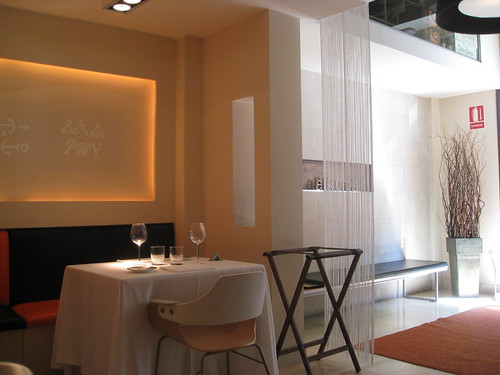
I began with a simple but memorable shot of tomato water with bread crumbs on top and a slice of fuet covering the glass. These simple ingredients provided a happy start in a restaurant that respects its food.
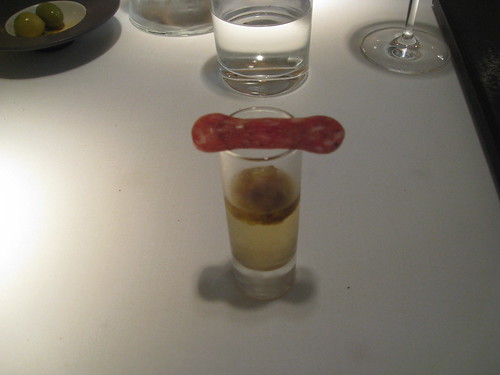
This amuse was followed by a lovely and bright compilation of Zucchini flowers, tomato, quinoa, olive oil, and gorgonzola ice cream. These carefully calibrated tastes were effectively and beautifully combined in a small glass in which each taste worked in tandem.
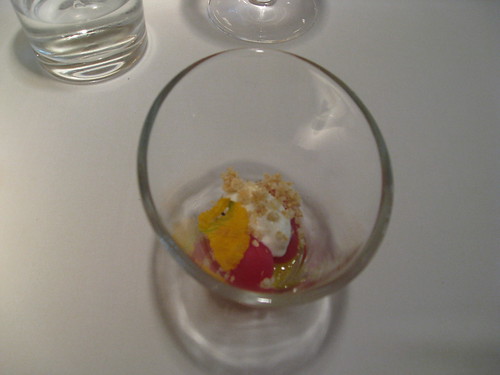
The most astonishing dish of the afternoon – still on my tongue after several weeks – is a composition (the proper term for so many of Chef Vila’s creations) of watermelon, smoked salmon, blanched almonds, with ajo blanco (white, garlicky gazpacho). Despite the seemingly odd mixture, each bite was a triumph of flavors that matched salty to herbal to sweet.

Chicken Cannelloni with almond béchamel and an apple and radish salad was another dish that was stirringly composed. I found it less compelling that the previous plates – less savory perhaps, but I did admire the stylish side salad on the plate.

Red Mullet (snapper) with tomatoes, peaches, and almonds was confident and, again, beautifully composed. Perhaps it was slightly salty, but the accompaniments were delightful reminders of late summer. Here is a chef deeply and confidently in debt to modern cuisine.

Two desserts concluded the lunch: the first was a riff on a traditional Catalan dessert: pastry with lemon sauce, vanilla ice cream and coffee cream. The second, the better of the two, was a fruit compote with melon, lychees, ginger water, plum cake, and lemon ice cream. An outdoor dessert served indoors. This dessert – not heavy a bit – almost floated away.
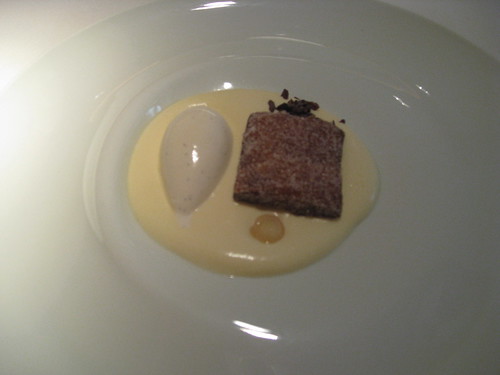

And like the dessert, I floated. In most cities, this meal would have catapulted the restaurant into the local heavens. The fact that this was Barcelona! means that Alkimia is part of the culinary chorus.
Alkimia
Industria 79 (Eixample)
Barcelona
93/207-6115
-
Second Best --- Xaviar’s at Piermont
The truth of the high-end restaurant biz is that it is not so hard to create a good quality restaurant. A clever chef, able decorator, and well-trained servers should do the trick. Creating a remarkable restaurant that soars and that captures the imagination of diners is another matter. I recently shared a fine meal at Peter X. Kelly’s Xaviar’s, the well-regarded restaurant in Piermont (on the west side of the Hudson across the Tappen Zee Bridge on the Palisades).
Xaviar’s is considered by some to be the second best restaurant in north suburban New York (Piermont is in Rockland county right across the Hudson River from Westchester County), following Blue Hill at Stone Barns. This is not exactly being the second best restaurant in Bakersfield or Toledo. I had eaten at Stone Barns shortly previously, and then at Xaviar’s, and the comparison is not fair. Xaviar’s would surely be the best restaurant in Bakersfield or Toledo. It was good – two stars (of four) good, but not poetic. This need to adjudicate quality is at the heart of the critic’s task. Few restaurants stink (certainly Xaviar’s doesn’t) and even fewer are transcendent.
The word that comes to mind in describing Xaviar’s is pleasant – in truth, not a bad word: a pleasant evening out is to be hoped. The room is not luxe, but comfortable (one can easily judge from the restrooms). The staff is friendly and competent, even if one doesn’t have the feeling of being in the hands of professionals, and the menu is engaging.
If one doesn’t select the chef’s tasting menu (we didn’t), one chooses from a four course menu for Seventy Dollars. At restaurants of this class, one begins with an amuse: grilled mackerel on a kimchee crepe with a miso sauce. Bravo. I was impressed that chef de cuisine Kathleen Egan engaged with kimchee. Although this (mild) heat was not characteristic of the evening, it was an amuse that woke up one’s mouth.
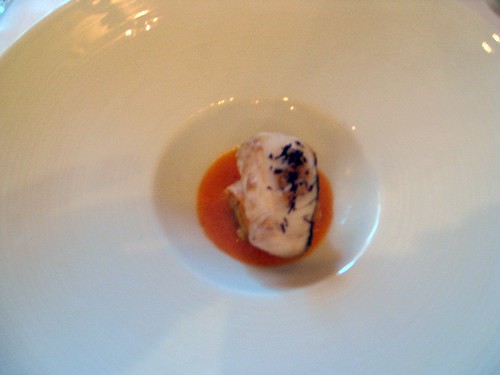
The first course, Seared Maine Diver Scallops with Braised Fennel and Hibiscus Glaze, was a nice starter. Perhaps the glaze was slightly sweet and the scallops were good but not astonishing. Still, the fennel added a surprising and pleasing spicy note. Fundamentally it was a straight-forward dish (i.e., had I the inspiration I could have prepared it), but it was a happy start.
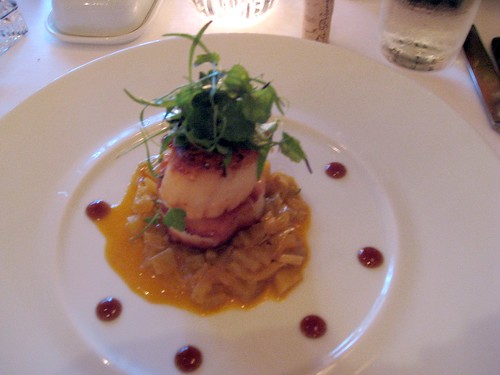
This was followed by the seafood course for which I selected Spaghetti Chittarra with Jumbo Lump Crabmeat, Green Onions, and Toasted Bread Crumbs. While the crabmeat was generous and sweet, I found the dish somewhat bland. Too quiet for a restaurant with aspirations. It was less subtle than muted. My companion’s Macadamia Nut Crusted Ahi Tuna with a Cucumber/Seaweed Salad was well-cooked with a lovely tart salad. Not an elaborate dish, but a very satisfying one.
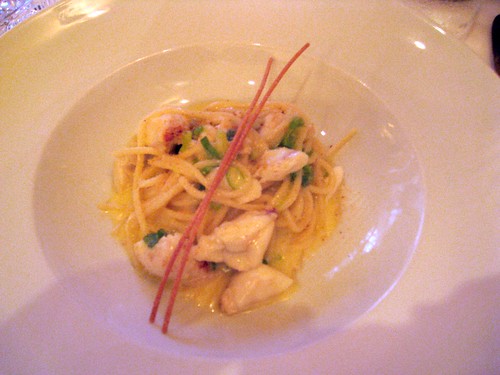
Third course was a brined and oven roasted Hudson Valley Chicken with mushroom wild rice and organic baby carrots. The sauce was an overly thick Madeira/morel sauce. The chicken was nicely moist, although I wished that the skin that was served had been crisp. The wild rice was not distinctive, and the carrots, although fine, could not compete with those of Blue Hill’s farm.
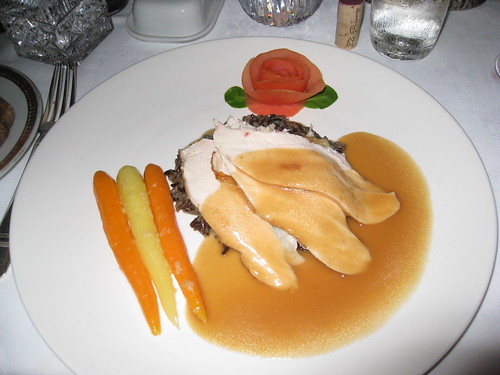
For dessert, I chose the Hot Cherry Souffle with Cherry Sauce and Lemon Sorbet. This was an excellent close. Presented as a soufflé should be, each bite was infused with cherry essence. With the exception of the amuse, it was the highpoint of the meal. The sorbet was a pleasing accompaniment.
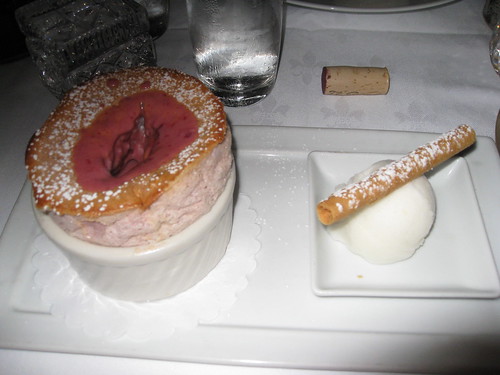
Xaviar’s at Piermont is a worthy restaurant. Whether it is second-best in the suburbs north of New York City I cannot say, but it would be in that mid-range of nice Manhattan restaurants. Sadly on this lovely Friday night in September, the restaurant was startlingly underbooked. We were not alone, but the number of filled tables could be counted on one hand. Perhaps Xaviar’s day has passed or perhaps good is simply not good enough in the burg of Piermont.
Xaviar’s
506 Piermont Avenue
Piermont, New York
845-359-7007
-
Catalan Cookery
Part One: Jamonisimo, Abac, El Celler de Can Roca
Any account of restaurant life in Barcelona and its environs must begin with El Bulli. So I confess that during my six days in Catalonia I did not eat at El Bulli. Perhaps it is just as well because El Bulli has become at least as much of a shrine as a restaurant. (I cannot comment on the shape of Chef Adraia’s cuisine or the validity of the religion for which he is the godhead). However, attempting to acquire a reservation eleven months prior to the date of our visit proved unsuccessful and no amount of waiting, pleading, or networking gained a table. This stands in contrast to the platonic El Celler de Can Roca (a Michelin three star restaurant), which still had open tables during the lunch that I dined in Girona. Could El Bulli be eleven months more fantastic than Can Roca? I can’t judge, but must speculate that at least some of those months may be attributable to our celebrity culture.
Still, my week in Barcelona was not without glories: Jamonisimo (*), Abac (***), El Celler de Can Roca (****), Cinc Sentits (****), Comerç 24 (**), Botafumeiro (*), Alkimia (****), and Drolma (**). There were some disappointments (Comerç 24 most dramatically), but there was not a bad meal. How many cities might one say that of? Paris? New Orleans once upon a time? New York, if one is careful?
Arriving in Barcelona in late morning, I set my sights on what I imagined would be a light lunch: a smidgen of Spanish ham: Iberian jamon. Near my hotel was a modernist and elegent jamoniserie (my term), Jamonisimo. Primarily a purveyor of dry cured ham, Jamonisimo has a few tables in back where they serve their wares. Perhaps it was due to our uncertain communication, but when I ordered Iberian ham in three textures (the parts of the leg from which they derived was shared for my edification), the plate was larger than I imagined (and could have easily satisfied several ravenous beach volleyball squads). But what an introduction to Catalonia! With dinner served at 9:00, pigging out at lunch was not a tragedy. The slices and chunks had subtly different tastes, density, and moisture, and the experience was distinctively different from an American country ham: richer and less salty. As I chomped, I couldn’t avoid thinking of Bill Buford’s Dante-quoting butcher, wondering whether such a butcher stood behind Jamonisimo.
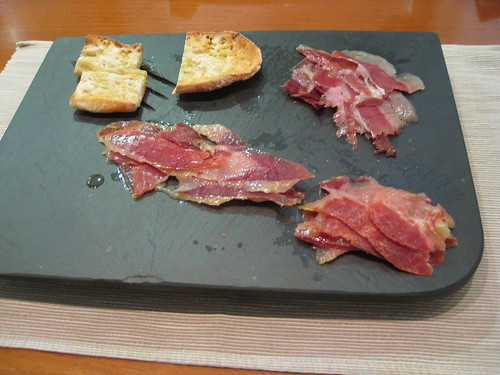
Dinner brought me to Abac where an al fresco dinner was filled with pleasure, even if I could not claim that the meal was transcendent. Still outdoor dining in a splendid little garden on a warm late summer Catalan night provided hours to be treasured, and a worthy comparison for other dinners. I remember particularly one of the opening snacks: crispy veal, tasting for all the world like a meaty potato crisp.
Equally appealing was an appetizer that consisted of a lovely textured soup, part foam, part mousse, part liquid. An emerald vichyssoise, combined with scallions, leeks, and asparagus. This was a libation that coolly contrasted with the still summer evening. Perfectly made, perfectly enjoyable. However much work went into its construction, its elegant simplicity was a diner’s joy.

I also enjoyed the sashimi quality tuna, raw on the inside, with a cherry gelee and sangria sauce. The tang of the fruit complimented the fish well. While not a unique presentation or set of flavors, it was successful. Similar was the pigeon with cardamom and onion, served with a well-composed salad. The cardamom might have been pushed up a notch, as the flavor was muted, but the game was luscious.


Of the desserts, I particularly enjoyed the sculptural passion fruit with cream sauce and spun sugar. As is typical for Abac the flavor combinations are not astonishing, but the dishes reveal real sophistication for the mid-range of diners. I was not stunned, but it was a fine way to share a first evening in B-lona.
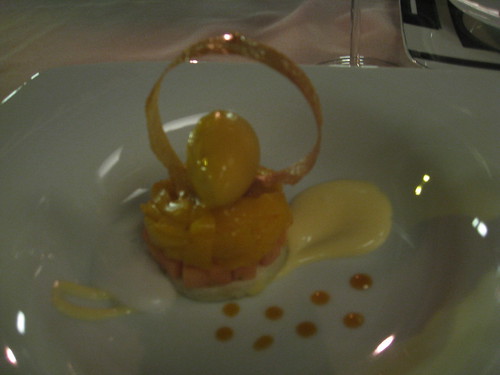
In contrast, platonic is the word for my visit to El Celler de Can Roca, a sleek and airy restaurant on the outskirts of Girona set in a peaceful modernist garden setting. One of the effects of having El Bulli down the road is that there is no need to compete in startling excess. Can Roca offers poetry to E.B.’s cracked science. But through it all the effects of a cuisine agape are evident. El Celler de Can Roca reveals a distinctive style, a style that owes much to sous vide techniques, capturing a density and purity of taste. However, sous vide does not scream at a diner. Not told that one’s meat was cooked sous vide, the marks of the process are hard to pinpoint, other than that the dish seems remarkable tender and flavorful, exquisite in taste and texture, but without blaring headlines.

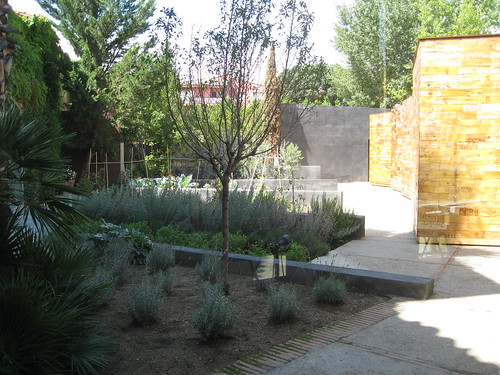
At a restaurant of the quality of Can Roca, anything less than the tasting menu would be a sin: and I rarely sin at table. My tasting notes are, rather redundantly, filled with the word “amazing.” Chef Joan Roca is in confident control (along with his brothers, Josep, the Sommelier, and Jordi, the Pastisser).
Still the less dramatic “snacks” make the rest of the meal look astonishing in comparison. Weakest was baby carrots with orange, stick and sweet, but not clever. Better was a nicely prepared lavender crisp and the lovely bitter cherries with campari and anchovies.
But it was the second opening course that persuaded. This was among the most experimental presentations of the luncheon. Actually it consisted of a trio of courses: ‘Sferificacion’ of Cockles with Guava Juice and Campari (Sferificacion is an El Bulli-derived technique of controlling the gelification of a liquid to provide desired shapes), a skin of cucumber soup with popcorn made of garlic soup, and a luxuriant and very Spanish pigeon bombon with Bristol Cream sherry. The last, appearing to be a cross between a truffle and a mallomar, is an exquisite game pie in a single bite. It heralds autumn. The cucumber soup is perfect in its edgy elegance, rich with herbal flavor. I loved the cockles, particularly because of the bitter and cocky campari-reprise. Although there didn’t seem to be a strong connection among these three starters, eating them in sequence was delight.
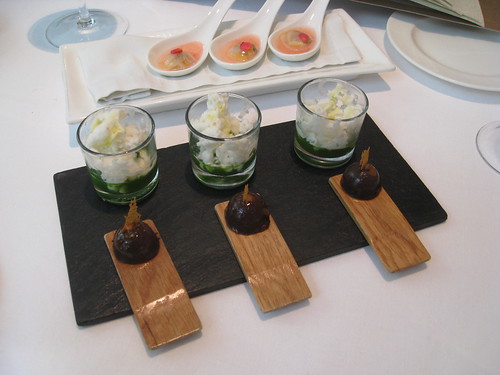
Oysters with with Agusti Torello cava, apple compote, ginger, pineapple, lemon confit, and spices was modernist salt-spray fruit salad, coordinated to emphasize the briny taste of the mollusk. Here was complex deliciousness that was both clean and oceanic.
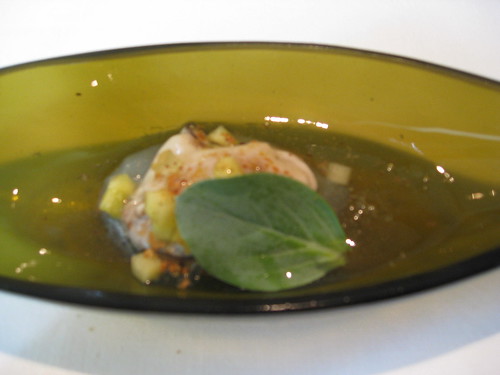
Melon with cured ham was a trompe l’oeil triumph: an extrusion of melon with fine Iberian ham. Conceptually this was cute, but the heart of the plate was the superb cured ham. One could almost taste the acorns on which the pig once feasted. No lipstick on this porker, but it was still a pig.
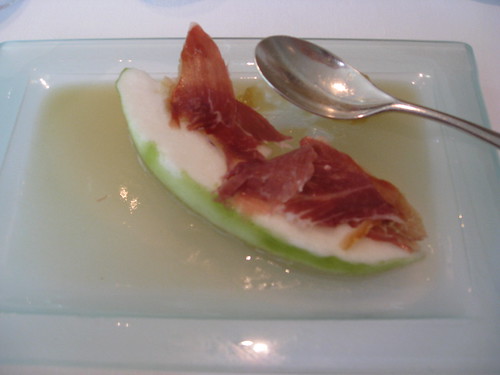
This was followed by a magnificently imagined taste festival. Not experimental, it represented modern cuisine’s desire to explore the boundaries of taste: Cherry soup with shrimp and a scoop of ginger ice cream mixed tart and rich, warm and cold, with every element skillfully prepared. This was an astonishing dish. From now on I will serve my shrimp cocktail with jam.
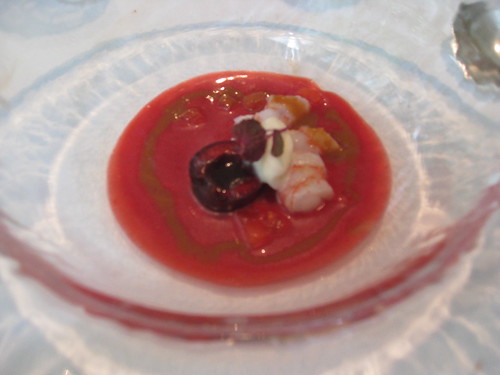
Green olive parmentier with foamy tuna sauce was another experiment in taste: an egg-like lump, playing on the imaginings of olive and potato: a tuna salad from the far future. Perhaps the taste did not compare with the cherry soup, but it combined tastes and textures with élan.

The following pair of dishes – amontillado-steamed king prawn and smoked summer-truffle soufflé – depended on splendid ingredients, impeccably cooked. Neither had sharp strokes of contrasting tastes, but their subtleties were delicious. The truffle soufflé was so sensuous that it deserved to be eaten in bed.

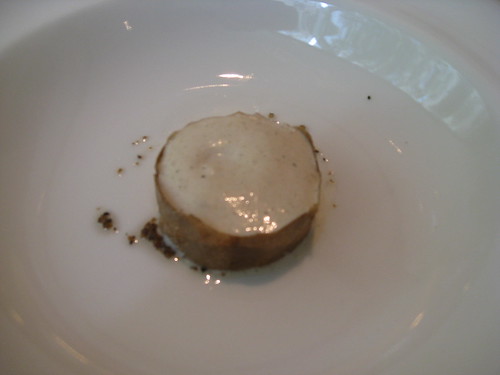
Sole with sea fennel and charcoal-grilled leeks bowed to classic cuisine (sous-vide classic, of course). Many modern chefs seem at sea with sauce, but not Chef Roca. Silken, foamy sauce with fish cooked by God’s hand, its elegance can not go unremarked. This plate reminds us why so many diners loved – and love – classic cuisine, even as lightened with low cooking and roux-free saucing.

Kid belly fillet with goat’s milk parmentier consisted of a rectangle of goat belly (today’s “in” body part) with perfectly crispy skin. This presentation was far more modern that the sole with just enough potato pudding and goat sauce to provide for an interactive experience. Another sumptuous dish.
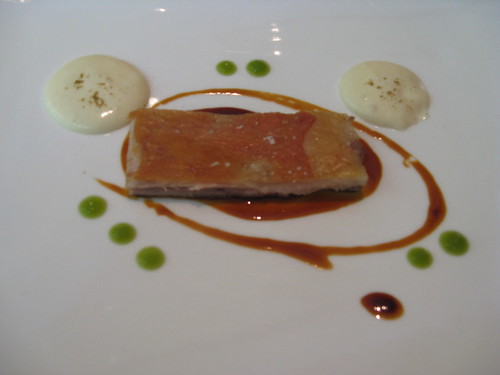
Goose liver terrine with apricot compote is Chef Roca’s tribute to the foie gras wars. Foie, but not gras, it had a gaminess that foie gras can never equal, evoking the wild in ways that depend on the pungency of goose liver. This was a powerful plate. As foie gras is meat jam, Chef Roca’s foie is a treat from the hunt.

Dinner concluded with a pair of desserts. First was a decorative dish labeled “A fragrance adapted: Extreme by Bulgari (Bergamot cream, lime sorbet, tonka bean, vanilla and patchouli).” The idea seemed precious, but the dish was a decorator’s dream. Not my favorite of the afternoon, it was a pretty mix of textures, tastes, and aromas. Not knowing Extreme fragrance, I cannot tell whether it matches, but I surely would prefer Extreme on warm skin than cold glass.

Cherries with vanilla and amaretto, draped with a clear sugar wrap, completed the cherry trilogy. I love cherries, and found this ending to be filled with smiles.
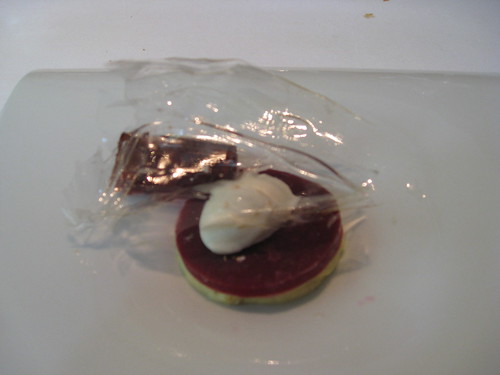
Were it not for its colleague down the road, El Celler de Can Roca would be goal of any gourmet’s pilgrimage. Bravo.
END OF PART ONE, CATALONIAN CUISINE
Jamonisimo
Provença 85 (Eixample)
Barcelona
93-439-0847
Abac
Avenue del Tibidabo 1-7 (Tibidabo)
Barcelona
93-319-6600
El Celler de Can Roca
Can Sunyer 48
Girona, Spain
972-22-21-57
-
Hot Quito Nights - Zazu
Anyone who has spent time in the sweaty kitchens of haute cuisine haunts knows that Ecuadorians are South America’s gift to North American diners. So many kitchens workers in New York, Chicago, and elsewhere hail from this small land, the size of Nevada, but without the sand and glitz. In a recent visit to Ecuador I searched out Ecuadorian haute cuisine. I can report that I discovered such an establishment, an astonishing one, although a restaurant whose innovative chef, Alexander Lau, hails from Peru, Ecuador’s prickly neighbor to the south.
After a misguided first night culinary adventure in Quito, I came upon Zazu, and not willing to leave my good fortune to the vagaries of Ecuadorian cuisine, I returned the next night, the first time as a grazer that I have eaten back-to-back meals in any restaurant. (This post recounts the first meal: photos from the following night are on my flickr.com account).
Ecuador decided some time back not only to peg its currency to the U.S. dollar, but actually to use American currency. Americans need not change money. This decision no doubt seemed wise in the age of a strong dollar, but today Ecuador is a value for American tourists, no more so than at Zazu, where a full seven-to-nine course tasting menu costs an astonishing $35.00. Most of the wines poured (Chilean, Argentinean, Spanish, and an untasted Ecuadorian wine) are priced at about $30.00.
We were particularly fortunate in selecting Zazu on a lazy, summer Monday night. For much of the evening the stylish, contemporary restaurant was nearly empty, and we received considerable attention from the waitstaff and the chef, including an invitation to explore the kitchen. The tasting menu consisted of nine courses, each stylish and most spicy. I don’t believe that I have ever had a tasting menu flavored with so much heat. (The tasting menu the following night – a busier, peppier evening - had some wonderful dishes - including a sea bass in coconut sauce, langoustine in piquant sauce, and shrimp in a honey-chili sauce - but was less thematically coordinated, and as an evening repast slightly less satisfying).
Dinner began with a simple amuse, Pangora (Pacific) stone crab set on a small round of avocado with bits of lettuce and tomato on a quiet Zen-like platter. Unlike much of the rest of the meal, the taste was cool and sweet without a hint of spice. The dish was impressively restrained and the ingredients were sublime, but the taste revealed little of what was in store.
The second dish was inspiration: raw sole with a parmesan sauce: a cheesy sushi with chili peppers. I admit that the vision of the dish may not be what one expects on a restaurant plate, at least when one is able to keep one’s food down. But this is a dish that can be eaten up, down or sideways. Raw fish, cheese sauce, and chili: this dish is doomed to failure, except for the fact that it is so glorious in its surprises; so lasting in its memories. I fell in love with Chef Lau. At its best his cuisine has the power to reimagine cuisine. Never have I witnessed a top chef pack so much heat. Not weeping heat, but a mix of classic and hot.
Third we were treated to sashimi tuna, with sesame oil, sesame seeds, and more chilies. Pure fish, pure heat, pure fun.
Fourth course was a perfectly tender Calamari, stuffed with shrimp, drizzled with a Ponzu sauce and more hot peppers. While such a string of chilied dishes might seem redundant, they never did. Each had its own flavor profile and its own set of culinary references.
The fifth plate was a seafood composition: shrimp, grouper, octopus, and calamari with tree tomatoes (a common Ecuadorian vegetable), garlic, and some more peppers. While the grouper was slightly overcooked for my taste, the dish followed the piscatorial theme of the dinner. The dish was well-designed and enjoyable – and exotic with the fruity tomatoes - if not quite so imaginative as several preceding dishes.
Sixth course was prawn tempura served with a spicy mango salad. This dish, elegant, composed, spicy, represented the heart of Chef Lau’s cuisine. He draws upon Asian and Latin ingredients and flavors but with a classic sensibility. While the dish was not as dramatic as his sole sashimi with parmesan sauce, it was astonishing in its creative simplicity.
Our seventh course was aged beef tenderloin with green peppercorns served with a dill and caraway sauce and green salad. On this plate the pungency did not come from heat but from the other side of the pepper world. The beef was nicely undercooked and enriched by the depth of the source.
The finally entrée course was an ossobuco, served on risotto with asparagus tempura. As with the opening course, an enveloping mildness characterized this plate. While ossobuco can be heavy in the wrong hands, this small plate was surprisingly airy and well-portioned.
A lovely, light taxol (passion fruit) sorbet followed with a small fan of spun sugar as garnish.
Desserts, while successful, are less stunning (and were also slightly disappointing our second night when I was presented with a sampler of desserts, none of which was a knock-out). I enjoyed a vanilla panna cotta, served with a salad of raspberries, strawberries, and mint. I wished for a more tropical or peppery ending or one with greater surprise, but the dessert was sweet and light. My wife received a chocolate panna cotta with berries, served on a cinnamon crumble. Nice indeed, but without revealing the pastry chef’s magic art.
Not each dish is equally stunning, but dinner at Zazu was a revelation: a wise, generous and zippy Latin cuisine with Asian and European influences. Chef Lau is an important chef in Ecuador and in the global culinary world. With a wave of tourists soon descending on Quito for the 150th anniversary of The Origin of Species, hopefully Chef Lau and Zazu will receive their due. This most fit restaurant deserves to survive and prosper.
Zazu
Mariano Aguilera 331 y La Pradera
Quito, Ecuador
(02)254-3559
Photos available on:
-
Waters on the Beach – Restaurant Robert Sudbrack – Rio de Janeiro
Despite the claims of Aussies, cuisine (like so much else, it is alleged) is a treasure of the Northern Hemisphere. Wishing to disprove this snippy claim, on a recent visit to the beaches of Rio de Janeiro (a conference on climate), I searched out the restaurant that can lay claim to being the most serious dining spot in Brazil (or at least in Rio). This is Restaurant Roberta Sudbrack, a smart boîte, located in a stylish neighborhood near Rio’s Jardim Botânico.
If I expected a nouvelle Cariocan cuisine, it was not to be. Roberta Sudbrack is Chez Panisse’s southern cousin: simple preparations, high quality ingredients, a comfortably elegant but unadorned space, unpretentious service: Berkeley by Bahia. Brazilian cuisine is particularly known for their caloric Saturday lunch feast, the feijoada – black beans, white rice, pork tails and ears, tongue, boiled beef, Spanish sausage – but this was Thursday night and the meal was stripped to its gourmet essentials. In our conversation Chef Sudbrack described herself as self-trained; a cookbook reader – influenced, she claims, by Joel Robuchon, although I saw less of his influence than that of Chef Waters. Chef Sudbrack, if perhaps lacking the requisite apprenticeships, is not without experience. Before opening her eponymous restaurant three years ago, she was chef for Brazil’s former sociologist/president Fernando Cardozo. Perhaps her restrained style derives from having to serve cheeky and picky world leaders. What would you serve Fidel and W?
I have long admired Chez Panisse, although I have never fallen passionately in love with the style. It is too dispassionate, too spare, too Quaker-meeting. Insufficiently samba. Sudbrack is a trip from the tropics, not to them. But this is Roberta Sudbrack’s vision. But given its mantra: local high-quality, organic provisions, simply prepared, it succeeds in its own terms with panache. The menu changes daily, depending upon market availability, a strategy that gives the produce priority over inspiration: imposing, canonical dishes take time to come marinate in the chef’s imagination: not the hours between sunrise and supper.
While the service was generally congenial, after a few photographs of the (three) amuses, our server/restaurant manager requested that I not photograph the food under I cleared it with the chef, due to arrive in a few minutes, and how proved most obliging. As a result, I lack images of two of the middle courses. At a place such as Sudbdrack, the dishes do not scream “look at me!” They are more taste-worthy than eye candy.
Our first amuse was perfectly composed tomato jewels on toast: a mild, clean, clear dish: bruschetta on circles of Holland rusk. This amuse doesn’t waken one’s mouth as much as cleanse it. It was carefully and cautiously prepared, if lacking in drama.
The following amuse was another spare on-toast presentation: Okra caviar on toast. Not a bit of Rio, but subtle without okra slickness. The idea was clever, but the taste, although pleasing, trailed behind the idea.
Our “official” amuse was a half-moon of foie gras with small pieces of pineapple and tarragon. What made this dish tingle were added salt crystals. Chef Sudbrack created a plate of smiling texture, even more than inspiring tastes. Although perhaps the pineapple was a nod to our venue, it owed more to a classic cuisine of ingredients. I loved Chef Sudbrack’s preparation, even if I cannot pretend that it was a stunning gustatory innovation.
The first appetizer was a deep-fried langoustine roll with new vegetables. Buttery crustaceans stuffed the crackly cigars. Lush, if reminiscent of high-end Chinese cuisine. These golden cylinders were surrounded by miniature carrots, broccoli, asparagus, green beans, and beets: the bounty of the well-tended garden.
Salt again featured in the next dish: Farm soft-boiled egg with shavings of asparagus surrounded by squares of buttered and salted bread. No dish could be more emblematic of the locavore movement: an egg, some bread, a bit of butter, and timely vegetables: all fresh and new. One will not confuse this cuisine with the fireworks of Tom Keller, Gordon Ramsey, Alain Ducasse, or Grant Achatz, but it was fine and true, reminiscent of New York’s Prune or Chicago’s North Pond. Keep it simple, keep it pure, and they will come.
The main entrée was roasted duck leg, cooked over low temperature, with a lovely and evocative (if not notably Brazilian) cauliflower couscous. This dish could hardly be simpler, yet it was lovely in its delicacy. I could smell the baby cauliflower wafting from the plate as chaste as cuisine can be.
Dessert proved a rich, dense, and naughty chocolate tartlette with an ice cream, memorable for its fluffy egg white texture. Another beloved and straight-forward dish, none the worse for letting flavors speak for themselves.
By the close of the evening we no longer expected cataclysms, just the delight of organic, local materials prepared with respect. Perhaps one would not travel half way around the planet, trailing carbon credits, to try cuisine that is available close to home (which is, after all, the point). Still, this truth does not weaken the calm call of Restaurant Roberta Sudbrack for wise Cariocans.
Restaurant Roberta Sudbrack
Rua Lineau de Paula Machado 916
Jardim Botânico
Rio de Janeiro, Brazil
55.21.3874.0139
http://www.robertasudbrack.com.br
Photos on:
-
Joia to the World – Joia – Milan
Although the betting line on Italy asserts that one cannot get a bad meal, my month-long visit proved – some nights – to disprove that culinary bromide. But forget those forgettable nights. This memory is a glorious – and surprising – meal, a lunch actually, in Milan (my most treasured meals were invariably lunches; dinners matter less).
I was nearly at the end of my stay without a truly astonishing meal. It was almost chance that I stumbled upon Joia, the lovely restaurant of Chef Pietro Leeman, a Swiss chef, trained by Freddy Girardet in Crissier at his Restaurant de l'Hôtel de Ville, according to some the world’s best restaurant in the 1980s (my meal, under Chef Girardet’s successor Philippe Rochat, was certainly world class). Chef Leeman has been cooking in Milan since 1989, and while one can see some echoes of Crissier, there are also dashes of Michel Bras, Hester Blumenthal, and Alice Waters in his cuisine: unfussy, playful, and seasonal, a half-step from vegetarian (with a few fish choices). Chef Leeman defines his style as “Alta Cucina Naturelle,” but this does not quite do him justice, ignoring his desire to subvert the relationship between the diner and chef, more characteristic of cuisine agape, a cuisine of amazement. In our postprandial conversation, Chef Leeman was quick to differentiate himself from molecular cuisine in his refraining from using the more experimental cooking techniques (he added foam to one memorable dish, but perhaps, foam is the new butter). His dishes aim for poetry more than science, as evidenced in the brio with which each dish is named: “A Stone Rolls,” “Virtue,” “Moving With Deliberation,” and “Blub”). Diners may find these zenish labels charming or pretentious, as they will. Several dishes are interactive, and perhaps a little too jesting in spirit. Chef Leeman does more than cook, he thinks and feels.
For my luncheon I ordered the five course spring tasting menu (all vegetarian). I began with an amuse: a shot glass filled with a soupy parfait: lime, puree of flageolet beans, and balsamic gelee. This was everything that an amuse could be: cool, awakening, filled with surprise, and a showcase for the chef’s talents to come. Although no one would describe Joia as an “Italian restaurant,” the use of the wondrous balsamic gelee serves to indicate that Chef Leeman can work marvels with Italian ingredients. The mix of lime, beans, and vinegar might seem preposterous, but the solidity of the beans served to bind the lime and the vinegar. A great start.
The first appetizer, “Contact and Consent,” was perhaps too precious in conception. I was presented with two small trays with three objects each: the left tray was designed for touching, while one ate the parallel ingredient on the right. On the left was a small glass filled with ice studded with flower petals, a sprig of rosemary, and a stone: Haiku Cuisine. Facing these were, in turn, snow pea and tomato soup, a zucchini flower stuffed with pea puree with a dab of mustard and dill, and asparagus on a fried chickpea square. I loved the sweet and simple soup with its swirls of red and green, and the well-made zucchini flower, alternatively pungent and smooth. I confess to feeling a bit foolish touching the stone, an exercise that had some of the excess of wearing earphones to hear the ocean at the Fat Duck. Tastes, not contraptions, are their own reward.
“First to the Left, then to the Right” was another interactive dish. The chef provides three small glasses: cream of zucchini, puree of Tropea onion (allegedly a Calabrian aphrodisiac, as if Italy itself were not Viagra), and a yogurt and horseradish curry. First the instructions, then the dish. Consume half of the cream soup, add the puree, finish half of this mixture, then add the curry, and finish. Gustatory miscreant that I am, I tasted each vessel before mixing and matching, but eventually fell into line. The outcome was quite satisfactory, although I could easily have had a bowl of the cream of zucchini or the zucchini/onion mix. The chef might have simply prepared three bowls as he wished, rather than demand his non-union clients collaborate, but it was a treat to see how his flavors spiral, reaching a crescendo.
What might a dish “In Praise of Tradition” mean at a vegetarian restaurant? The dish, meatless, was robust without attempting to recreate meat. Chef Leeman served bread dumplings, roasted chestnut, and carrots with snowpeas and Castelmagno cheese (a semi-hard, Piedmont cow’s cheese). The dish was impressive, capturing the stewed features of tradition, while still being airy and sprightly, and very much the chef’s creation. It appeared hearty – and was – while not dismissing the bearable lightness of a naturelle cuisine.
The final main course, “Beneath a Colorful Carpet,” included a lovely array of morels, asparagus, smoked ricotta, lightly spiced zucchini, and arugula pesto. This mixture was napped by a foam of saffron and (separately) raspberry. I was afraid that this would be a jarring excess (and I might have replaced the raspberry with mint – although the berries were well-modulated), but this dish was astonishing and so spring-like, one might have imagined one was in the woods, rather than in traffic-choked Milan. Unfurling vegetables so gloriously revealed the power of a meatless mind in the kitchen.
My dessert was known as “Ah.” Oh. And it was something of a gibe, referencing more classic presentations. The dish arrived under glass with smoldering incense, shades of Grant Achatz’s odorous cuisine, giving the plate a smoky aspect. Chef Leeman prepared Cream Catalan with cherries, bolstered by a scoop of lush pineapple ice cream and a cup of passion fruit juice, the plate dotted with saffron and cherry sauce, reprising the saffron/raspberry foam of the previous course. As in a symphonic production notes reappear in new forms. This was a compelling plating of cream and fruits, with the springy twist of late memories of an incense and intense evening. Here was fruit salad, reimagined.
What is the inverse of an amuse? A lagniappe, perhaps. A reprise of the fruit juice: pineapple with notes of raspberry and ginger. The small glass was sheathed with a soft wafer of banana and chocolate that obligingly slid into the drink. As Chef Leeman’s entrees pay tribute to vegetables, his desserts are paeans to fruit.
Joia is a splendid, startling, provoking restaurant. Its small, elegant, but somewhat humble, space separates it from a palace of haute cuisine. And the Chef’s desire to provoke may cause some second thoughts. But measured bite-by-bite, eating at Joia is an astonishing afternoon. This midday I selected the abbreviated menu, but next time I will ask for the Chef’s finest hours. I am sure that he will – comically, mystically, poetically - oblige.
Ristorante Joia di Pietro Leeman
Via Panfilo Castaldi, 18
Milan
02-20-49-244
Photographs at:
-
Vie is for Volume – Vie
There is a thin sounding board – a line in the decibel sand – between excitement and exasperation. Restaurants as organizations appeal to their market niche not just in cuisine and cost, but in clamor and clatter. And the politics of noise can be the undoing – or the doing – of sterling restaurants.
Last Saturday, frightened by the ongoing repairs on the Edens Expressway, feeling cut off from the Chicago dining hub, my wife and I headed west: to Western Springs and Vie, a restaurant that I had once visited on a calm – nearly empty – Tuesday night. Arriving Saturday night at 9:00 p.m. we were escorted into a jangling, buzzy dining space (Vie has a warren of small spaces, not well soundproofed). Despite polished service and Chef Paul Virant’s impressive and confident locavore, seasonal cuisine, what was most memorable about the first half of the meal was the roar of conversation: and this in a restaurant where the tables are not snugly packed and the diners are not screaming sweet nothings. While the core of a review should properly be what is on the plate, it was sound that was on the mind. If Vie hopes to compete with the Chicago luxe restaurants and not to be a glorious bar-and-grill, Chef Virant needs to call his decorator. He gets an earful from this diner.
Given that this review lacks a sound track, I turn to the Chef’s doing. At most restaurants the appetizers are the star: the meal goes downhill from the start. This is not true at Vie: our entrees stole the show. True, my wife ordered a salad (Local Lettuces, Marinated and Shaved Fresh Hearts of Palm, Garlic and Herb Vinaigrette, Parmigiano-Reggiano), and, true, she enjoyed it exceptionally. For me it was a nicely done play on a Caesar-type salad, impressive within the genre.
My appetizer was Wood-Grilled Gunthorp Farm Duck Breast, Cracklings, Arugula, Black Raspberry Aigre-Doux, and Tatsoi (a type of bok choi; Vie helpfully places a glossary on their menu). The combination was very nice indeed, although I found the duck undercooked (mostly a problem of texture). With duck cooked more to my liking, this would have been a superior dish, especially because of the remaining textures and the pungency of the flavors.
As a main course my carnivore partner selected Marinated and Wood-Grilled Painted Hills Strip Steak (provenance is vital at locavore haunts), Baked Wisconsin Cheddar Toast, Local Asparagus, and Creamed Spence Farm Ramps (no other farm will suffice!). As with my appetizer, the meaty center of the meal was enlivened by a set of pungent companions. The dish didn’t need Worcester to have zip and zing. The beef flavor and texture did not dominate but was nicely matched.
My entrée was splendid. Throughout this mid-May menu Chef Virant teased the diner with seasonal morels in various guises. And I finally gave in to morels, baked crepes, goats milk ricotta (I believe), green garlic vinaigrette, and local Bordeaux spinach. The dish was a triumph. The morels were perfectly tender (and well-cleaned) and the garlic and crepes matched them bite for bite. Chef Virant is as expert a vegetarian as is Chef Trotter (whose vegetarian menu often surpassed his open menu: even with foie gras!). This was the dish that I will treasure: Vie is for Virtuosity.
Desserts were both successful. Baba Au Rhum is difficult to destroy, but Vie’s version – Baba Au Whisky, Dooley’s Toffee Liqueur Ice Cream, Candied Walnuts, and Caramel Sauce – is very lush. Without the whisky, it might have been too sweet, but the alcohol keeps the sugar at bay. The warm Caramel Gooey Butter Cake, Almond Chocolate Chip Ice Cream, Almond Lace Cookie, and Almond Toffee Square was also sweetly striking. Although I am not a fan of “gooey” as a gourmet adjective, this cake was gooey. The toffee square was more chewy than I prefer. It was more taffy than toffee, but well-made.
Vie consistently turns out impressive cuisine. While not aiming for a pastoral environment, Chef Virant has made Vie into a destination, not only when the Illinois Department of Transportation directs traffic his way.
Vie
4471 Lawn Avenue
Western Spring, IL
708-246-2082
www.vierestaurant.com
For photos, go to:
-
I had a very successful meal at 33 Liberty this week (I wished that I could have eaten there twice, but it was not to be - I also had a nice meat-and-three meal at OJ's and an OK dinner at Pomegranate, a Persian restaurant downtown).
33 Liberty is not yet a "destination restaurant," but the food was always well-cooked, and some was really excellent. Greenville has come a long way with the influx of non-locals through their BMW and Michelin plants. The downtown is really quite "spiffy."
33 Liberty is, however, not downtown, but in a rather unprepossessing area on the east side of the city (the Spartanburg side), if my sense of direction is correct (about ten minutes from the airport). The restaurant itself is quite informal, given Chef Malik's culinary efforts (the menu changes on a weekly basis). I don't mean this in a negative way, but the mismatched (and sunny) decor will either be pleasing or off-putting. This doesn't have the feel of a high-end Atlanta restaurant - again, either a positive or not. The service (our waitress was Christina) was very pleasant and charming, but also informal. And in the dining room chef John Malik's wife Amy was dining with her children (she also runs the restaurant). 33 Liberty has almost a family restaurant vibe (and is quite different from, say, Hugh Atcheson's Five & Ten restaurant in Athens).
The dishes were generally excellent, although perhaps not as pretty as, say, Five & Ten. I particularly enjoyed a terrific amuse of White Bean soup with truffle oil. An evocative start, simple, properly made, and classical. I also throughly treasured the smoked sea bass spring rolls with green salad and buttermilk dressing, my favorite dish of the evening. The spring rolls were crispy and not at all greasy, and the seabass was nicely smoky without being overwhelmed. The salad, simple, complimented the plate. I also enjoyed the rabbit rillettes with croutons, homemade mustard, and cornichons. Not an A-ha kind of dish, but straightforward. The roasted beets with goat cheese, sherry vinaigrette, and pound cake croutons were most notable for the surprisingly wonderful and sweet croutons. Otherwise the dish was well-made and honest.
The main courses were likewise pretty straight-forward, but always well-cooked. Lamb shank with whipped potatoes and peas was as advertised, as was a tender, juicy pan-fried veal liver with whipped potatoes and Vidalia onion sauce. How often can one order properly cooked veal liver.
Dessert was a high point: a buttermilk chess pie with grapefruit marmalade. I was impressed by how the bitter-tartness of the marmalade matched the pure sweetness of the pie.
If I am near the Greenville area, I will certainly return to John Malik's 33 Liberty with great pleasure. The visual and taste profiles of the dishes are not now so dramatic as to make 33 Liberty worth a drive from Atlanta or from Charlotte, but chefs must be attendant to the preference of potential diners. With entrees priced at about $20, there are limits to the magic of the kitchen, but such pricing also means that 33 Liberty is not only for special occasions.
33 Liberty
33 Liberty Lane
Greenville, SC
864-370-4888
-
Schwa and Frolic - Schwa - Chicago
Six of us visited Schwa last weekend. Typically Schwa limits its tables to parties of four, but on Saturday Michael Carlson called and informed me that because of cancellations, we could expand our table. We embraced his generosity.
I have been to Schwa four times, and have enjoyed my meal each time, but I felt that this evening Chef Carlson was at his most assured and confident and his happiest. There were fewer missteps, and – dare I say it – he looked more relaxed: more ready for beachwear than a hospital gown. This is how a career should be. While the interactions were never unpleasant, tonight there was a joy that had not been evident previously. Fatherhood does that (for awhile) and a few (four) friends.
Chicago boast numerous consummate chefs: kitchen artists who can create stunning meals: Trotter, Nahabedian, Liccioni, Bowles, Achatz, Tramonto, Bayless, Stegner, Joho, Kahan, Cantu. Michael Carlson is among that elite dozen. But his restaurant is not like any other. Unlike David Chang or Jose Andres, he does not pass food across a counter, but cooks and serves and scrapes the pots. I feel myself blessed to visit Naha, Trotters, Frontera every few years, but I want to visit Carlson each season. The fear at its opening was that Schwa was a mirage, a culinary unicorn: it couldn’t exist, and that someday – soon – I might kick myself for not making that last reservation. I kicked last October. Perhaps every chef wants – in fantasy – to do it all, but this is also the hope of the diner. It is nice to be greeted by Chef Trotter, but it is something else to show Chef Carlson that the parsley is misplaced (no parsley tonight!). Schwa is a divine chimera. If I had to choose a last meal in my chill cell, perhaps it wouldn’t be Carlson’s dishes I would first salivate after (except his canonical lusty quail’s egg ravioli), but if I were given a one-night reprieve it would be Schwa that I would visit, and explain to Ashley Dupree that I was engaged. What is remarkable is the creation within that small space on Ashland of a single, momentary community of cooks and diners. I like and admire servers, but let it be me and the stovemen. (I never fantasize about coolly-precise servers, no matter how cute, as long as there are hot cooks about).
I was struck by how carefully Chef Carlson separated and calibrated his flavors and textures. Carlson is less a chemist in the style of Cantu or Achatz than a literary critic: he likes to consider, rearrange, and interpret ingredients as they create a “dish.” His style is not precisely molecular, but it treats a dish as a text to be sliced and diced.
To start at the end. Desserts have been the weak link at Schwa. Pastry chefs have a language that most chefs speak only in pidgin – and the translation between the two accents may be rough as Sam Mason came to realize after receiving pastry encomiums at the sweet genius at wd-50, he was crucified when first opening Tailor in New York. With the small staff at Schwa, desserts seemed – well – half-baked. Not tonight. Dessert was sweetened candied veal sweetbreads with ice wine vinegar caramel, passionfruit culis, lavender foam, and a dehydrated parsnip chip. Although deconstructed dishes often have the disadvantage of being “a little of this, a little of that,” forcing diners to reconstruct the chef’s ideal in their clumsy way, this dish was compelling it its separation, not even considering the literary conceit of the punny sweetbreads.
Dinner began with a complex and refreshing amuse of grapefruit vesicles (cells) with honey sorbet, chamomile agar and black truffle shaving. (I credit both “CG” and “wino66” - from LTHforum - for these borrowed descriptions – the Schwa menu is telegraphic, as is the rage at molecular restaurants: this dish is labeled “amuse”). Here was a lovely combination that was sufficiently robust that the truffle was overpowered. The flavor was dominated by melodious honey sorbet and tart grapefruit. The meal began and ended with the kitchen’s sugary touch.
The first course was notable for a brioche that will reside in any bakery hall of fame. We were served pickled Jonah Crab, a slice of dehydrated banana (the dehydrator works overtime at Schwa), batons of celery, celery root and a celery root puree. What was heroic, however, was an unprepossessing cube of brioche injected with hot banana liquor that didn’t just melt but exploded like Carnival. It is a challenge to explain a sensation that is as much tactile and olfactory as gustatory, but it was stunning: doubly mouthwatering.
This appetizer was followed by soup: a potent rich and salty beer cheese soup, made from Chimay washed cheese, served with a freshly made soft “pretzel hole” and a dehydrated mustard chip and an herbal smear. If not as stunning as the previous course, it was intense and intensely satisfying.
Now Chef Carlson returned to a trio of greatest hits. First, Pad Thai: jellyfish with thai flavors. It is a cute conceit and certainly flavorful as a small bite, but it was not a dish that I craved a second time, even though I had enjoyed it previously.
This was quickly followed by the Schwa Pine Cone (I am not certain if I have had precisely this recipe): sea urchin ice cream on a maple syrup flavored cone with some pine essence. The uni ice cream was a lovely palate cleanser, even if the cone was sweeter than necessary and needed a more dramatic pine essence.
Finally the quail egg ravioli. Still fantastic after all of these months. Brilliant. Erotic. Tampopo.
The artic char roe with pumpernickel coins, Meyer lemon puree and rutabaga consommé has been criticized for being out of balance with too strong a pumpernickel presence. Perhaps Chef Carlson has dialed back on this pungency or perhaps I just enjoy marked tastes, but I found the flavors and textures compelling and well-modulated: a remarkable take on caviar-and-blini. This deconstruction revealed true culinary bravado.
Kona Kampachi sashimi with galangal crisp, Lime gelee, maple mousse foam, salsify batons, and daikon disks was wonderful in all ways that a dish can produce wonderment in our firmament. Another deconstruction, this Japanois-inspired, and a very fruitful – reprising the candied mid-March maple-syrup theme of the meal: not too sweet (although the meal was more heavily weighted toward sweetness than some chefs might have dared).
The greatest revelation of the evening was the liver and onions. In a city in which liver has come to mean foie gras undercover: Chef Carlson presented a simple preparation with a disk of calves liver perched on a scoop of onion risotto. What not to like? With liver this sweet and rich, why pine over foie gras? Why duck into liver speakeasies? A dill smear decorated the side of the bowl with small cubes of bayleaf gelee, crispy shallots and pickled cipollini onions. Liver and onions rules!
Our final main course was antelope loin and leg, served sous vide, with butternut squash and white chocolate foam. Perhaps this dish suffered by its placement after the superb kampachi and amazing liver. The antelope was pleasant, the chocolate foam was well prepared, but by this course I wanted a miracle, not pleasure alone.
Our cheese course – once a memorable one-bite pungent (epoisse) cheese risotto, a signature dish of Chef Carlson - was tonight a small wedge of Humboldt fog goat cheese (with a truffled ash layer) and graham cracker crust. It tasted like Humboldt Fog Goat Cheese. Let the kitchen take a breather. And then dessert.
This was not only the most triumphant meal that I have had at Schwa, but the most fun. I revere the Jonah crab appetizer, the Kampachi, the liver and onions, and the Candied Sweetbreads, and, always, the ravioli. But I will mostly prize the experience of being served by a staff that seemed at their ease, having fun, and playing with their food and their admirers. Each hour of joy is a benediction.
Schwa
1466 North Ashland
773-252-1466
www.schwarestaurant.com
-
So Tomorrow --- Blackbird
I enjoyed a splendid lunch at Blackbird. A wonderful way to end a year of eating. The food at Blackbird really flies. At its best Chef Kahan's cuisine is as creative and accomplished as any chef in town, perhaps less elaborated but with a startling and compelling mixture of tastes and textures.
I began with baby octopus confit with braised chestnuts, empire apples, pea tendrils and sassafras caramel. This construction was as fascinating and wildly textured as any appetizer I have had for awhile. Chewy, crackly, smooth and crunchy. Sweet and just a bit sour. A truly magnificent dish.
As an entree I selected slow roasted duck with fried byrd mill grits, citrus brussel sprouts and puffed wild rice. I was blown away by the finely threaded brussel sprouts - the emotional heart of the dish. The duck, grits and rice, well-cooked, played a supporting role.
Dessert was a beautifully composed mission fig beignet with cara cara oranges, butterscotch and bacon ice cream. I have been rather critical of desserts as late, but not this. Like the appetizer, this was one of the most sensational and brilliant desserts of the year. The bacon ice cream seemed simultaneously surprising and totally natural. What a lovely way to end the year.
Why then is Blackbird not often listed in the company with other four star restaurants, where, by virtue of the food it belongs? When Blackbird opened a decade ago it was sleek and chic. But time has taken a toll on the restaurant. The restaurant no longer seems as stylish as it had once been. The plates don't need to be refreshed, but the tables might be. The room is so 1999! The food is so tomorrow!
Blackbird
619 Randolph Street (West Loop)
Chicago
312-715-0708
http://www.blackbirdrestaurant.com/
Photos at:
-
Purity and Savory *** Washington, DC *** CityZen
Schools must exist in which aspiring chefs are taught to name their culinary domains: Alinea, Per Se, Moto, WD-50, and Washington’s CityZen – a preserve for citizens of a certain level of refinement and resources. CityZen is located in the Mandarin Oriental Hotel in Washington’s new Southwest side. And before we get to the cuisine, the restaurant, although quite pretty is pretty in the way of upscale, contemporary, luxury hotel dining rooms. Serviceable in a post-Millennium sort of way. Speaking of serviceable, service was more than serviceable, it was congenial and helpful.
There has been debate about the level of cuisine at the new venture of Chef Eric Ziebold, formerly at the French Laundry. The food is indebted to Keller with its attention to combinations of flavors and textures, occasionally borrowing from – or contributing to – an experimental cuisine. But how far can Ziebold push his clients? Can Washington ever have truly outstanding cuisine: is that the cost of living in a town in which the prime hunger is for power, not flash, flesh, or fowl? After a recent dinner, choosing the tasting menu, I am among those who rate CityZen highly – except for the bread, more about that later. While my meal was not always astonishing, it was in most regards of the highest order with several remarkable dishes. In comparison to Citronelle, Komi, Kinkead’s, or even Minibar, it is CityZen to which I would first return. Ziebold gives prime of place to simple, simply prepared proteins and surrounds them by zesty combinations.
We began with a pair of amuses, prior to the tasting menu parade. The stronger of the two was a nifty fungal symphony: A toasted mushroom egg puff covered with mushroom powder. This fritter was an earthy, but otherworldly, tribute to late fall. The flavors were deep and the multiple textures clever. It did what an amuse should do, awaken one’s senses to future surprises by the depth of taste.
The second small plate (is the second amuse still an amuse: when does it become an unadvertised appetizer?) was what I recall as a garlicky mousse-filled gougere situated on a lentil salad. The pastry was as flaky as one could desire, although perhaps slightly salty for my taste.
Our first course was as dazzling as a Miró canvas: carpaccio of Atlantic Fluke with Gans Ranch Fuyu Persimmon (even fruit has a provenance), Puffed Japanese Sweet Rice, Micro Peppercress and Pomegranate Vinaigrette. The fluke when cooked properly is a mild and subtle fish, more thrilling for its texture than its taste. Dotting it were the other ingredients, transforming each bite. This is a striking dish, witty and cunning. The taste of the fish ebbed into the background, permitting the vinaigrette a gustatory ovation.
Grilled Atlantic day boat scallops with Belgian endive marmalade, citrus velouté, and lobster infused oil was another surprising dish in that, as with the fluke, the scallops, a mild seafood, furnished texture to savory supplements. Although scallops might not seem to be an ideal partner for a sour citrus, the addition of marmalade and lobster oil created a dish that was dreamy, if not dramatic on the plate. It was lush and tangy without being jarring or busy.
The third plate – Polly-Face Farms Poussin – was similar to the previous two in that it was based on a mild center and savory edges. Authentically produced in western Virginia with Michael Pollan’s blessing (despite the misspelling of Polyface Farms – not only green-card eateries that don’t spell-check), the poussin was paired with dried currant and Italian pistachio mousse with parsnip puree, sugar pie pumpkin and Swiss chard roulle. Simple and pure as the chicken was, the accompaniments made this dish special. The pumpkin and chard roulle was Chef Ziebold’s most memorable presentation of the evening. Again the chef maintains an austere urbane zen-like calm at the center of the plate while circling the center with pungent intensity.
The meat course was braised A1 Direct kuroge beef shortribs with marinated beets, cipollini onions and caramelized salsify (I don’t know what A1 Direct might be, but the firm seems uncomfortable like a company that attempts to cadge customers by being listed first in the Yellow Pages). The beef was itself more dramatically flavorful than the chicken, scallop, or fluke. However, the plate became innovative because of the surroundings, passionate beets and sumptuous salsify. Without the accompaniments this would have been a good dish, with them it was robust and flavorful.
Shortribs were followed by a nicely presented cheese course with some dozen cheeses of varying provenance (A1 Direct?). Since we talking cheese, bread comes to mind. The breads (raisin, bacon, sourdough) from Uptown Bakery were uniformly, uh, awful. CityZen Pain. A four star restaurant should not be serving bread that flirts with stale. I was informed that in 2008 CityZen will be baking their own bread, so clearly they understand their problem. Why an aspiring four-star restaurant would choose to serve bread this pathetic is a mystery. Are there no Ritz Crackers to be had? In fairness, the mini-Parker House rolls, prepared in-house and served with the shortrib, were terrific. They should have been on the table from start to end.
Of the concluding courses, I preferred the palate cleanser, pineapple sorbet with coconut foam and rum gelee. As refreshing as the taste, it was the compelling textures that make this piña colada appealing.
Dessert was cheesecake chiboust (a custard-textured cheesecake) with soft graham cracker and passion fruit sauce, a pleasant change from leaden cheesecakes, and like the earlier course, combined a mild middle with a tart accompanying sauce. However, this passion fruit sauce was not so dramatic as to raise the profile of the dish above the pleasant.
CityZen is a distinguished restaurant with a clever chef and clever name. Chef Ziebold has a style that combines a purity of protein with zippy purees, mousses, volutes, oils, vinaigrettes, foams, and marinates. Through his signature style, he forces us to recognize the perfection of central ingredients, even while informing us that there is wild culinary world outside the gates. This is a important message, even if it might permit us to recall the “just” chicken, seafood, or beef and slight the pungent skills of the chef that made it so.
CityZen
Mandarin Oriental Hotel
1330 Maryland Avenue, SW
Washington, DC
202-554-8588
http://www.mandarinoriental.com/hotel/535000039.asp
For photos see:

Town House Restaurant
in D.C. & DelMarVa: Dining
Posted · Edited by gaf (log)
The Peach, the Orange, and the Quiet – Town House – Chilhowie, Virginia
Once upon a time in America to desire gourmet dining meant one destination: not New York City, but midtown Manhattan. Slowly the appetite for culture spread from Gotham’s gut, and cities such as San Francisco, Los Angeles, Miami, and Chicago opened their own bathhouses of gastronomy. Diffusion marches on, and in 2010 we find destination dining in small-town America, Main Street meals. After dining fabulously well in June Restaurant in Peoria Heights, I ached to extend my range. (Restaurants in the same category are Revolver in Findlay, Ohio and Volt in Frederick, Maryland, although Yountville, California, home of the French Laundry, is a town as small as others, but a tourist destination, not a designation for Peoria). During a month in Highlands, North Carolina, I planned a three hour trek to Chilhowie, Virginia to sample the fanciful cuisine at Town House. Prior to 2007, Town House had been a small-town grill, but that year John Shields (sous-chef at Alinea) and his partner – now his wife – Karen Urie (Shields) (pastry chef at Tru) moseyed down to Southwestern Virginia (his home neighborhood, I believe) to reimagine Town House.
Town House is not rural, nestled in comforting woods with neighborly owls and bears. It is found on a small town main street. Its environs are not impressive in themselves (no need for valet parking). The design of the restaurant, modern and sleek, would suit Park Slope Brooklyn. The restaurant seems plunked down: a gastronomic room that happens to be in Chilhowie, not particularly indigenous (although some ingredients are local).
Town House offers four menus: a short a la carte menu (one salad, three entrees, and a dessert); a four course prix fixe (two choices for each course); and a ten course tasting menu ($110). We selected the latter, and added two intriguing courses from the prix fixe, a blessing as these were among the best courses. We also had a mini-version of Charlie Berg’s excellent wine pairings (not staying in Chilhowie, value seemed the better part of valor). Although I do not cover wines, they were well-chosen and a creative match (only the Foggy Ridge Cider was from Virginia).
I divide Chef Shields’ dishes into two: an ecstatic elegant minimalist style and the now-common modern cuisine, with busy plates covered with carefully shaped and processed ingredients. Chef Shields does busy food very well, but in a style that is often seen (this is also the style of Pastry Chef (Karen) Shields. What I will remember from here until hospice are the whispering dishes (Chilled Vegetable “Minestrone”; the Orange from Valencia; A Minimal Preparation with Peach; Scrambled Egg Mousse; and, from column B, Corn and Crispy Pig Tail. It was not that the other dishes were bad; they weren’t; they were impressive and represented the style well, but a few lacked focus (the desserts had this quality). At times the whole was less memorable than the sum of the parts. Town House cuisine pays respectful attention to texture (including, at times, temperature), but to my surprise, with a few notable exceptions the dishes were not visually stunning. The kitchen’s palate runs from white to tan to beige to brown and back again. It is not only the moderate lighting that makes Town House a challenge for photographers.
Soon there appeared a savory cookie of cocoa and black olive – a post-modern Oreo with Meyer lemon compote and parmesan cream. While I was impressed with the citrus cream filling, I found the cookie to be dry with a slightly oily mouthfeel. I should have revived my own oreo memories: removing the cookie and licking the cream.
It is dangerous to serve the best dish of the evening as the opening act. But at Town House this is surely the case. Chef Shields’ “Chilled Vegetable ‘Minestrone’” is an astonishing dish. It is a canonical creation, perhaps in the class of Keller’s Oysters and Pearls, or Michael Carlson’s Quail Egg Ravioli. Yet, Shields’ minestrone cannot truly be compared with this pair. Both are lush while Shields is restrained: Agnes Martin in a bowl. Like every goodly, godly stock the liquid is complex while appearing simple. This “soup” consists of 11 different (root) vegetables, rolled as small cylinders. We are served radish, beet, carrot, leek, and a chorus of others. Each has its color, creating a stunningly beautiful dish in a minimalist vein. Tasting each pipe, I realized that each had been cooked in its own herbal bath. The diner who ignores the vegetable consommé misses a high point of vegetable cuisine. It is a perfectly imagined dish, a virtuoso display of genius.
The second course seemed a scoop of orange sherbet sitting lonely on a plate: “The Orange from Valencia.” Here was orange puree, flash frozen. A tennis ball crammed with a savory mixture of shellfish – mussels, shrimp, and other oceanic nummies. Perhaps it was the surprise of a seafood bombe, but this was another wondrous dish. The contrasting temperatures and textures, combined with the cunning acidity of the orange puree, permitted a dish that provided a dramatic contrast with the minestrone, avoiding being overshadowed.
Soup of Cherries with “almond bread” (frozen almond milk), slow oven-roasted tomatoes, cucumber water, ginger, and sardines was the most challenging dish of the evening, perhaps of the year. Some 35 years ago I was served a dish at Larry Forgione’s An American Place on Manhattan’s Upper East Side. At that moment of culinary promiscuity, American chefs were attempting to develop a lusty American cuisine, using an array of traditions in a style that would become institutionalized as fusion cuisine. Forgione, then something of a celebrity chef, sent out a multi-layer tortilla torte with barbeque beef, corn, tomatoes, and salsa, and others ingredient I have striven to forget. The dish was a mess, a clashing composition of tastes and textures (my wife was served a stunningly velvet sole with sorrel beurre blanc). In contrast, my dish nearly inedible for all the right reasons. If art need not be pretty (think Richard Serra, brutalist architecture, and challenges to decorative art), must food taste good? Must all dishes be “comfort food”? I have discussed Forgione’s dish more than any other that I have eaten. Shields attempts something similar with his combination of cherry, tomato, sardine, and frozen almond ice. The ingredients bounce and slam around the plate: it is a hip-hop hors d’oeuvre: in your face before being in your mouth. There are some dishes (the minestrone) that I wish that I could eat every day, and there are some dishes that are once in a lifetime experiences. Sardines are not good bedfellows, but they have rough style. Sour, tart, oily, sweet, acidity, smooth: this dish was like no other most nights. Memories are made of such strains.
Scrambled egg mousse, a paean to breakfast, was fourth, and was another success. Although Heston Blumenthal of The Fat Duck places his breakfast dish – bacon and egg ice cream – at the end (perhaps to remind us how long we have been at table), this mousse is still an appetizer, and a lovely, quiet one. The scrambled egg mousse is served over smoked steelhead roe, sorghum, sweet spices, preserved ramp, and rye bread. I thought that the dish must contain bacon – it does not – but it captures most of the flavors that constitute bacon: sweetness, smokiness, saltiness. The texture is silky as one cuts into the mousse, hiding (as in the orange) complex deliciousness below.
Peekytoe Crab in Brown Butter and Lime with “caramelized onions,” banana, curry, and cider vinegar was in the style of modern cuisine’s symphonic dishes. Here was perhaps the most typical modern dish of the night. Chef Shields works with three basic ingredients: crab, banana, and onions, and then shapes them in various forms, textures, tastes, using multiple cooking processes. It was a virtuoso combination, but my concern with this presentation is that one never gets the same bite twice: there is not enough time to think about taste and texture before other tastes and textures intrude. Like many of the dishes the colors on the plate were shades of off-white.
The sixth dish was, for me, the most troubling dish, although one that I am reassessing. It was the dish for which I registered a complaint to Chef Shields; perhaps I spoke too rapidly. I was served a “Risotto” of Squid. Whenever one finds quotation marks on a menu, anxiety is about. This dish appeared a petite risotto, but one absent rice. The rice was squid cut as rice (surely a labor-intensive task). My first reaction was not happy. I would have preferred risotto sans quote marks: real Arborio rice is heavenly starch. In terms of sheer enjoyment I have not changed my stance. Yet, a week later I still think about the dish. The squid was deliberately chewy (some might say rubbery), not the meaty grilled calamari of Greek cuisine. By leaving out the rice, the dish had a creamy, aquatic purity. It was still my least favorite dish, but I can appreciate the choice. Perhaps it had something of the let-us-do-it-because-we-can sensibility, but it had a textual punch.
Now I received the first “extra” course: Corn and Crispy Pig Tail with basil-infused buttermilk, toffee, popcorn, and cocoa nibs. Like the crab this was a dish that is very much in the register of modern cuisine: a focus on the possibilities of corn with a butt wag to Fergus Henderson’s snout-to-literally-tail cuisine. This presentation brought to mind a stalk of corn, and is stunning as this style gets. The textures – gelatinous, smooth, stringy, chewy, meaty, liquid – were showy. Here was something other than a mish-mash, but a set of ideas. Corn and Tail is dramatically different from the quieter dishes (Shields works with several distinctive cooking styles), but is a vivid composition.
The foie gras royale, confit and crisp chicken skin (covered with a patch of fresh berries – a batch of fresh perries?) was easily the most vibrant presentation of the evening (my photograph shamefully lacks justice). What is not to like about duck liver and blackberries? Nothing, of course. To say that it was nothing special seems to demean the dish, but only in contrast. It is a dish that makes diners happy in three-star cuisine.
And then naked came the peach (“A minimal preparation of peach roasted in beef fat and chanterelle mushroom bouillon”), a second extra dish. If the minestrone had been out of stock, the little peach would have stolen my heart. I would be raving about this roast slice of fruit. If peach were filet how would it taste? Shields is a consummate consommé master. This was almost as perfect a two-bite dish as could imagine, so beefy, so woodsy, so filled with the orchard. Astonishing!
The entrée was Lamb Cooked in Ash with Smoked Eggplant Cream Puree, Miso, Black Garlic, Bonito, and pulverized potato starch. Shields serve a meat dish that is textbook, so filled with paper-like ingredients it was. Much was thin, wrinkled, and crackly, the floor of an academic office. I was stunned in its play with textures and its reflection of ash. Perhaps its bustle was overshadowed by the peach, but I cannot deny my pleasure throughout.
The two desserts, created by Karen Urie Shields, formerly of Chicago’s Trotter’s and Tru, are much in the modern style (her bread is simply delicious). First was Parsnip Candy with Aerated Coconut, Yeast Sponge, Banana, Maca Crumbs (maca is, apparently, an herbaceous root plant from Peru: a slap in the face of locavores?), and Lemongrass. Most impressive was the wonderful set of textures in this dish, another symphony in off-white. However, after a week it is hard to recall the tastes involved.
The second dessert was Blueberries and Lychee with Peony Sorbet (wonderful), goat yogurt, coriander berries (very distinctive), and crispy milk skin (the Shields could open a culinary paper mill). I love lychee and so I was pleased with the dessert, but it revealed the limits of modern cuisine, perhaps it was too impressive in its fireworks. If one preparation is astonishing, sometimes having five or six on the plate makes amazement routine.
My unasked-for advice for a brilliant ending is to create a dessert-equivalent of the minestrone. Choose eleven fruits, shape them beautifully, serve with a light, off-sweet consommé, and remind us again just how simple food can be complex. Or, if not, a nugget of veal served as a nectarine.
It took three hours to arrive at Town House and three hours to dine and three hours to return home. Three hours of expectation, three hours of reminiscences, and three hours of pure joy.
Town House
132 East Main Street
Chilhowie, Virginia 24319
276-646-8787
http://www.townhouseva.com
The restaurant has an associated guest house for those wishing a full wine tasting.
Photographs available at Vealcheeks